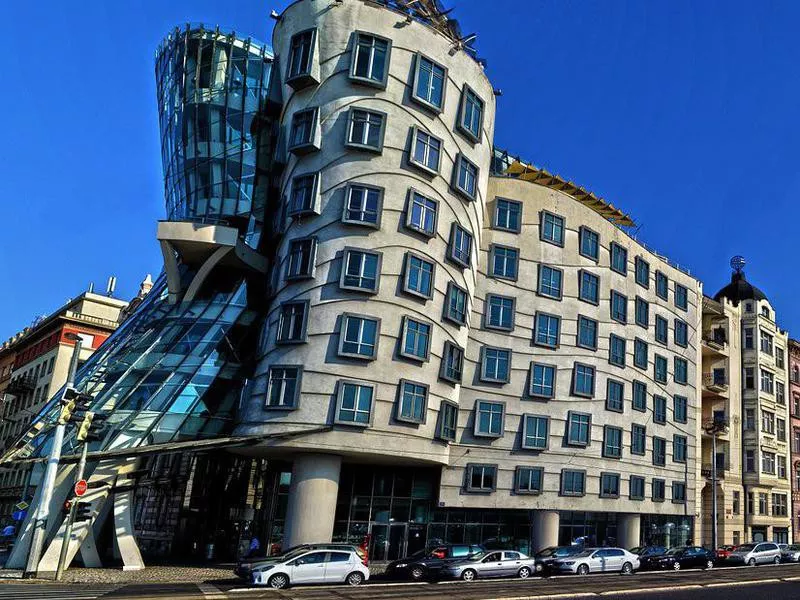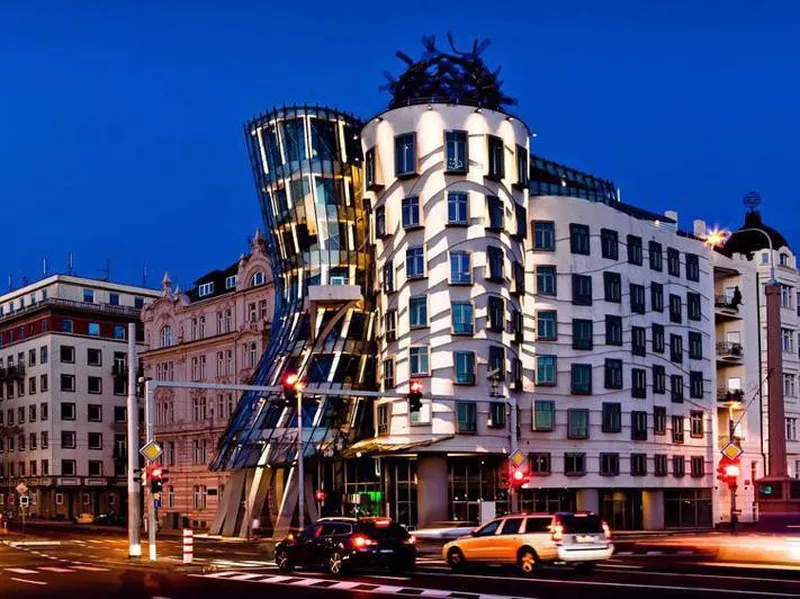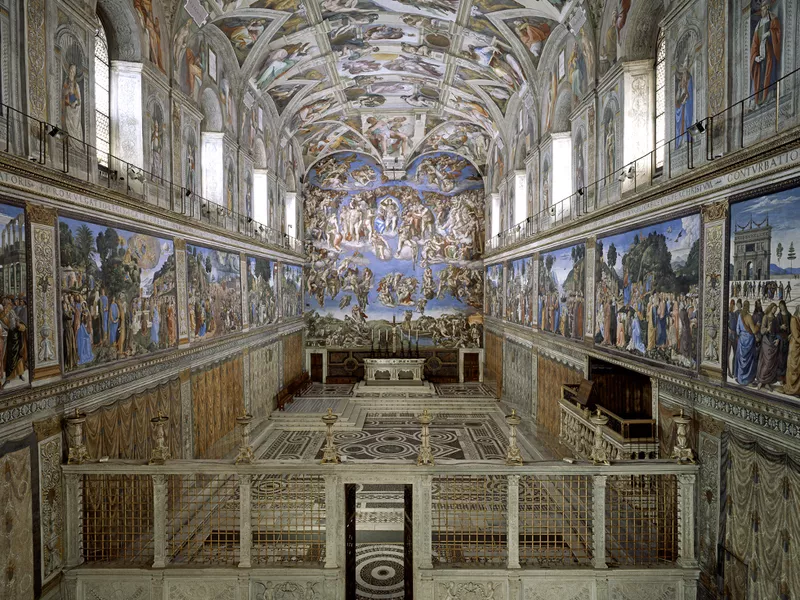The most famous buildings around the world are a testament to the human spirit for blending design, function, belief systems and a desire for legacy with new or time-honored technologies. Many of these structures or sites were so well built — think Machu Picchu in Peru or the Colosseum in Italy — that they have survived for millennia. They’re the pieces of architecture that have inspired artists, writers, musicians and travelers for as long as they’ve been standing.
Whether it’s the Sydney Opera House in Australia or the Eiffel Tower in France, these buildings define a country’s culture and how it continues to grow. We chose this list of 30 buildings — all from different countries — based on popularity as well as historic and cultural significance, and then we ranked them by the number of visitors they receive each year.
So, did your favorite piece of architecture make the cut?
30. The Dancing House
Location: Prague, Czech Republic
Architect: Frank Gehry, Vlado Milunic
Year built: 1994 - 1996
Square footage: 58,125 square feet
Bottom Line: The Dancing House
The Dancing House was built on empty space by the riverside in Prague. Then-Czech President Vaclev Havel commissioned the building, envisioning the space as a cultural center. The architects called their style “neo-baroque” and meant it to represent two dancers twirling around each other, inspired by Fred Astaire and Ginger Rogers.
The Dancing House was controversial at first but has since become a familiar and famous part of the city and was named one of the top five 1990s buildings by Architekt Magazine. The buildings contain offices, a restaurant, gallery, hotel and conference center.
29. The Great Mosque of Djenne
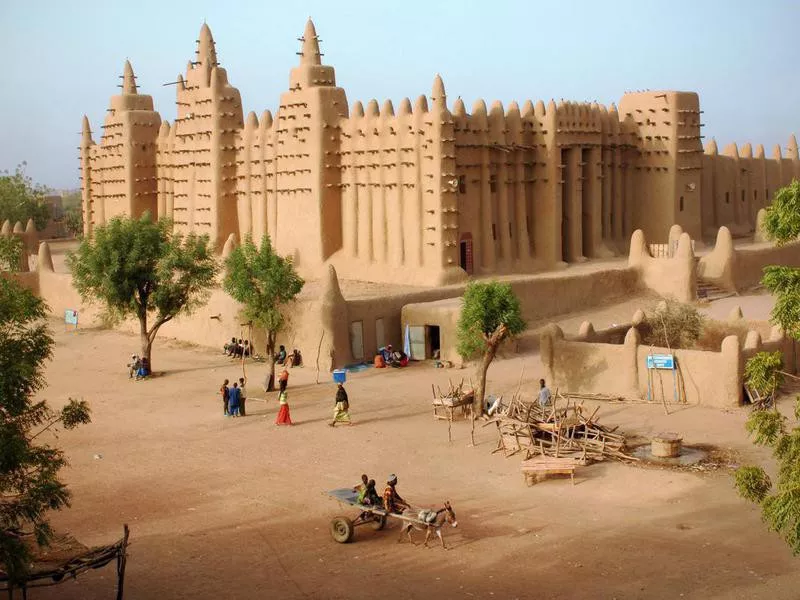
oversnap / Getty Images
Location: Djenne, Mali
Architect: Ismaila Traore
Year built: 1907
Square footage: 60,500 square feet
Bottom Line: The Great Mosque of Djenne
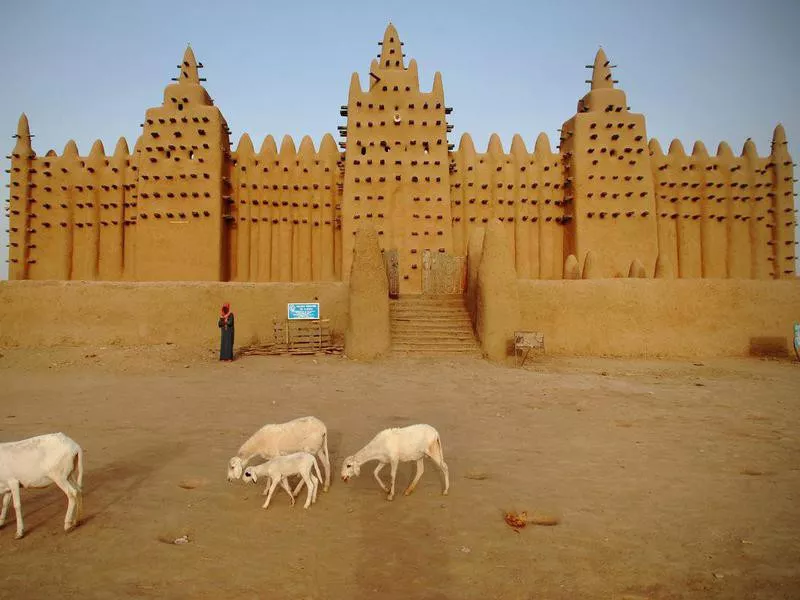
oversnap / Getty Images
The Great Mosque of Djenne is the world’s largest mud structure and the third one built on the same site. The first one was constructed in the early 13th century and became a religious center for the ancient pilgrimage city of Djenne, which served to spread Islam within Africa.
The mud mosque is part of the Djenne Circle, a ring of archeological earthen architecture sites. The mosque and the entire town of Djenne is a UNESCO World Heritage site. A civil war in the region has prevented tourism for several years, so no visitor numbers are available, but we think it deserved a spot on this list.
28. The Tarxien Temples
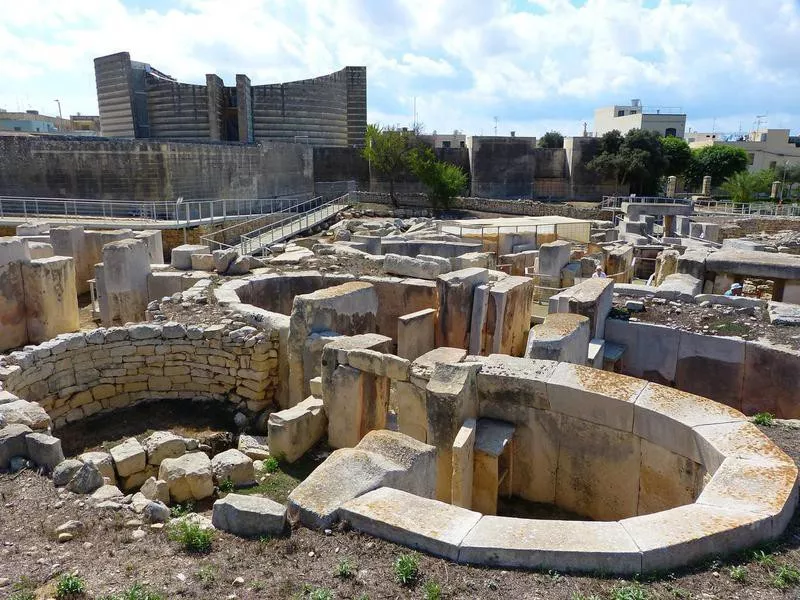
AlizadaStudios / Getty Images
Location: Tarxien, Malta
Architect: Unknown
Year built: 3600 - 2500 BC
Square footage: 86,900 square feet
Bottom Line: The Tarxien Temples
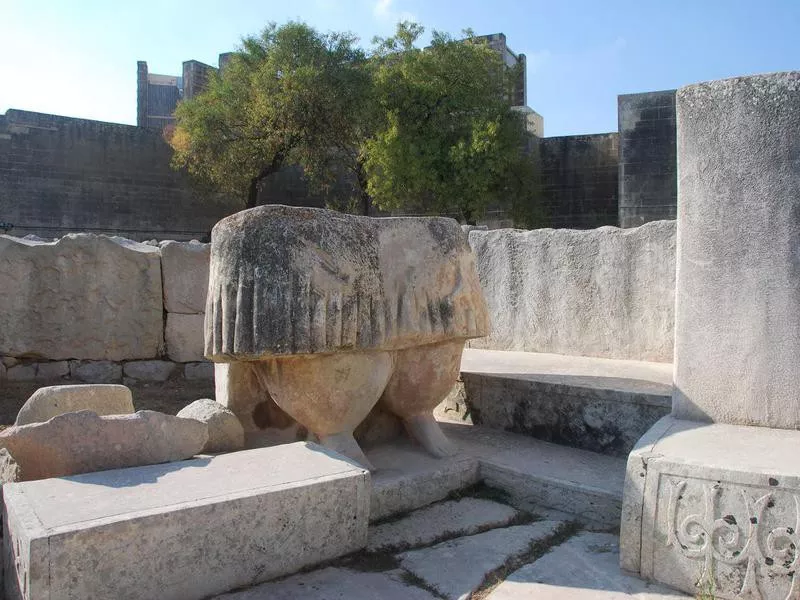
alanfin / Getty Images
The island country of Malta has a rich archeological heritage ranging from prehistoric stone temples to Crusader castles and forts, to historic churches and cathedrals. In 1915, archaeologist Themistocles Zammet excavated the megalithic complex of four temples in the town of Tarxien.
The complex is the largest group of temples on the island and a UNESCO World Heritage site. The site is most famous for the find of buxom female figurines called “Venuses,” showing Malta once had a female, earth goddess religion.
27. Petronas Towers
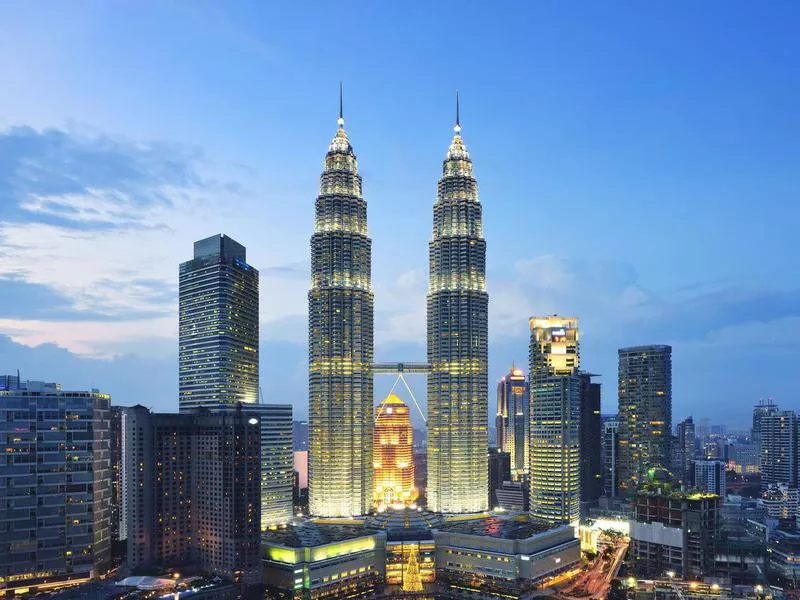
zorazhuang / Getty Images
Location: Kuala Lumpur, Malaysia
Architect: Cesar Pelli
Year built: 1993 - 1999
Height: 1,483 feet
Bottom Line: Petronas Towers
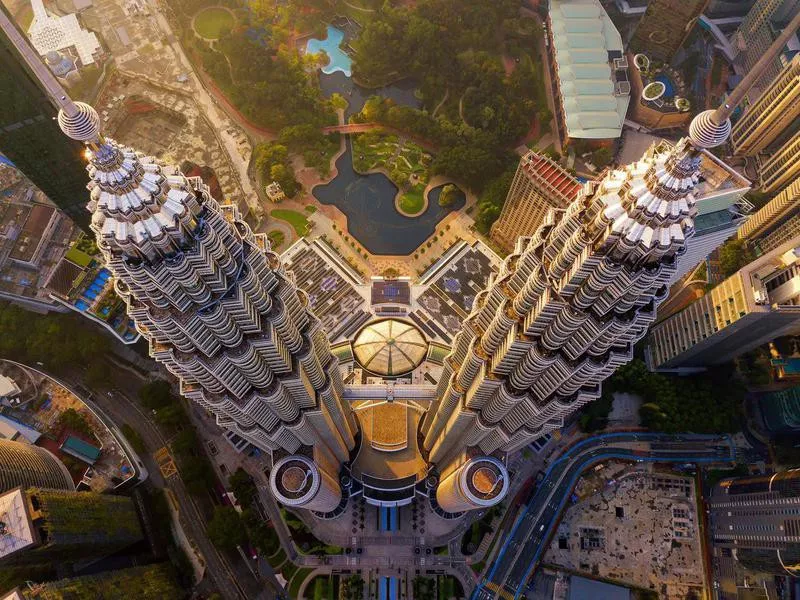
tampatra / Getty Images
The Petronas Towers in Kuala Lumpur are the world’s tallest twin structures, rising 88 stories high, and they’re the highest buildings in Malaysia. They were intended to resemble an eight-pointed Islamic star that stands for unity, harmony, stability and reason.
The towers contain multinational company offices, one of the largest shopping malls in the country, an art gallery, aquarium, science center and orchestral concert hall. The towers are one of the most popular tourist attractions in Malaysia. However, since 2010, only 365,000 people a year are permitted to enter the towers with pre-booked tickets.
26. St. Basil’s Cathedral
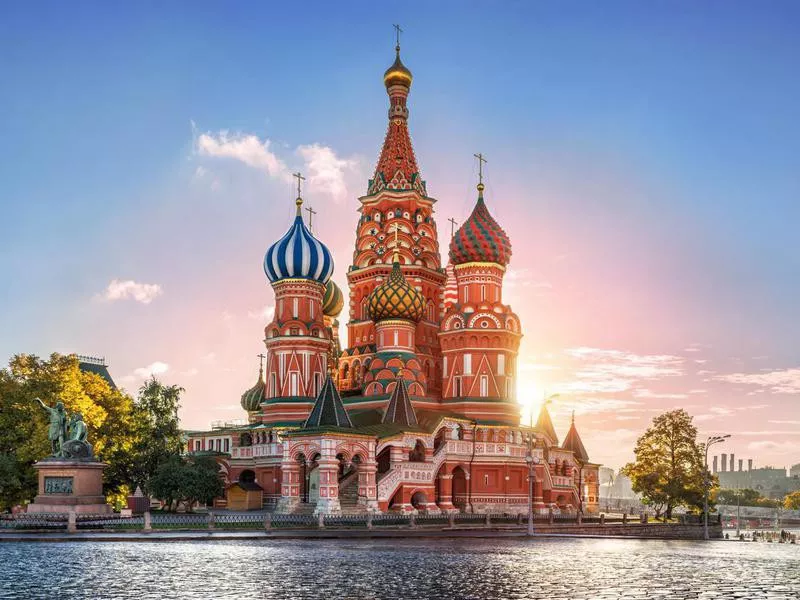
yulenochekk / Getty Images
Location: Moscow, Russia
Architect: Ivan Barma and Postnik Yakoviev
Year built: 1555 - 1561
Height: 213 feet
Bottom Line: St. Basil’s Cathedral
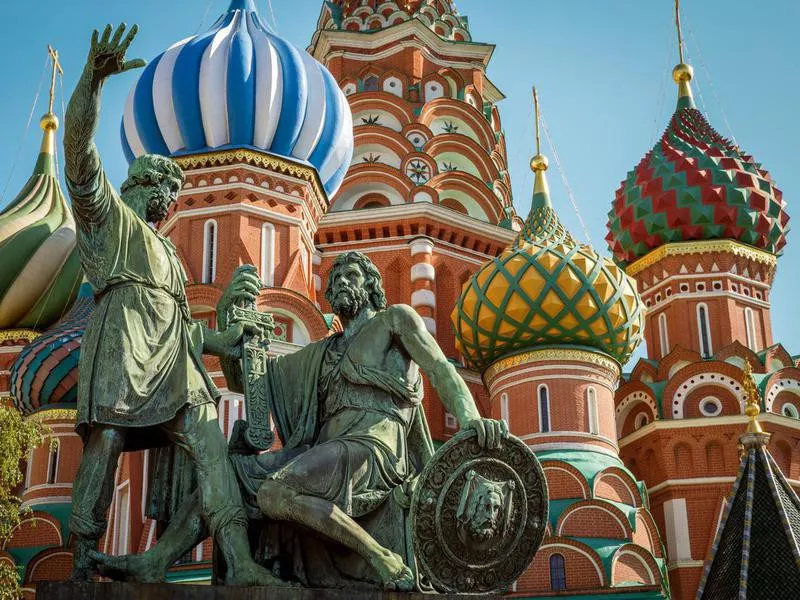
mikolajn / Getty Images
The Cathedral of Vasily the Blessed is a Russian Orthodox church built by Tzar Ivan the Terrible on Red Square as a military memorial to his victory over the last of the European Mongol rulers. The bright, colorful Cathedral with its onion domes and spires is considered to be Russia’s most famous landmark and is included on the UNESCO World Heritage list.
The ornate interior is made up of nine separate chapels connected by passages and galleries and contains a collection of 400 religious icons, dating from the 16th century. Accurate visitor numbers are difficult to find, but it’s estimated to be about 400,000.
25. Angkor Wat
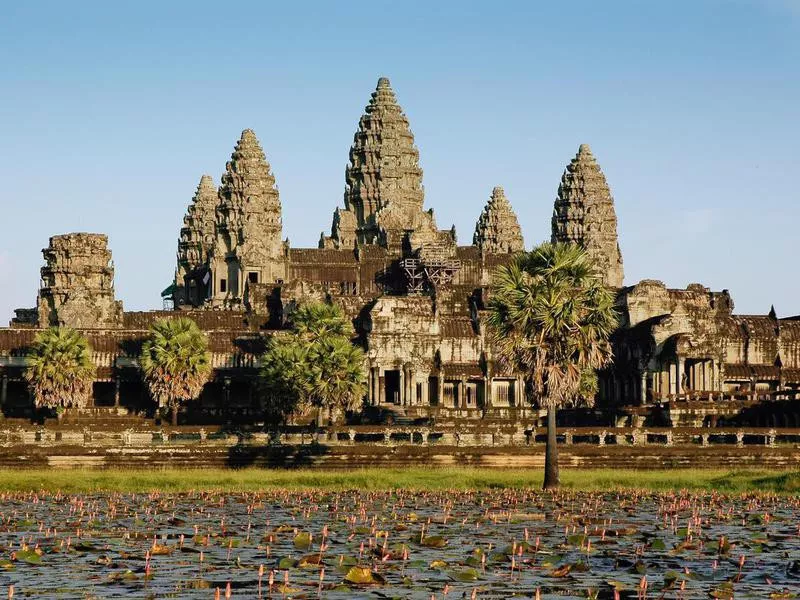
hippostudio / Getty Images
Location: Siem Riep, Cambodia
Architect: Unknown
Year built: 1150 AD
Square footage: 400 acres (17.4 million square feet)
Bottom Line: Angkor Wat
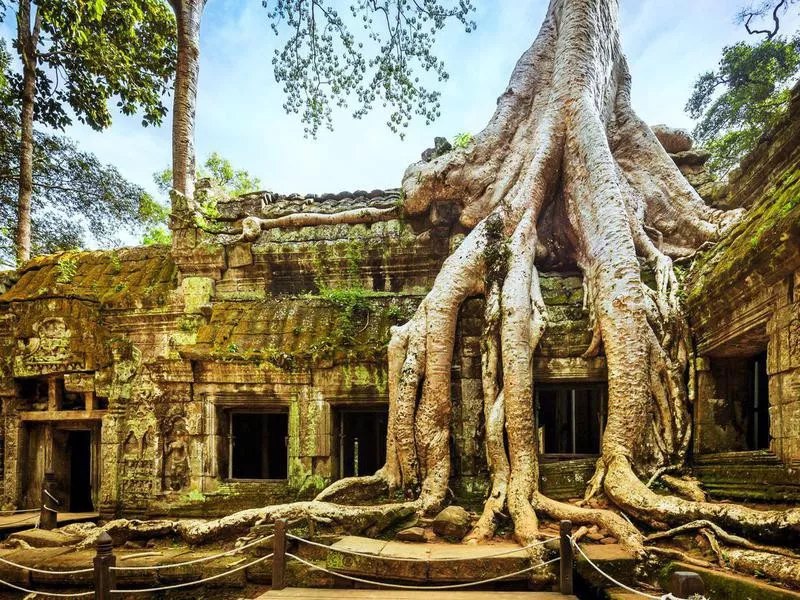
Nikada / Getty Images
Angkor Wat is a Buddist temple complex that was built around 1150 AD. The entire complex is thought to be both a temple and a tomb for the ruler who built it, Suryavarmman II. The city was the center of the Khmer Empire for centuries and the name translates as “temple city.”
The outside of the main temple area is surrounded by a 2,624-foot long carving showing the Khmer mythology and history. The site is on the UNESCO World Heritage list and is visited by half a million people annually.
24. Bran Castle
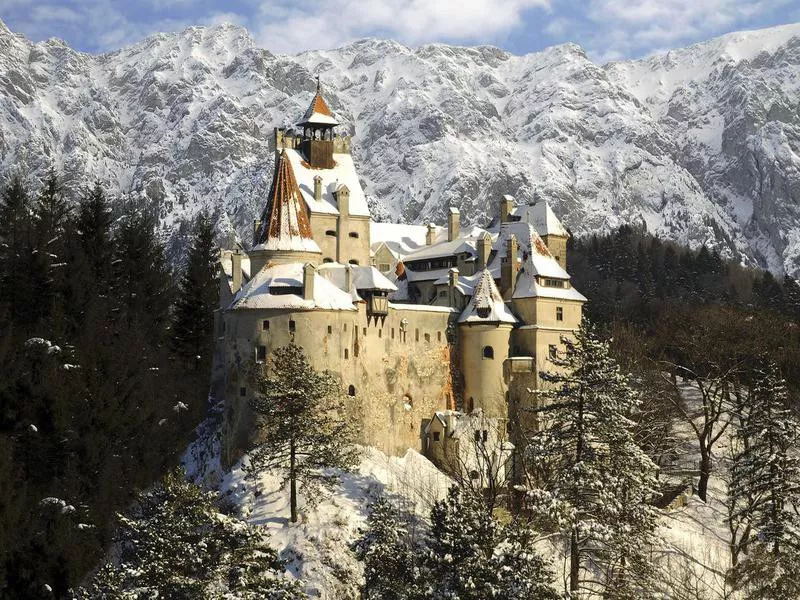
warmcolors / Getty Images
Location: Bran, Romania
Architect: Unknown
Year built: 1377 - 1388
Square footage of the site: 22 acres (958,320 square feet)
Bottom Line: Bran Castle
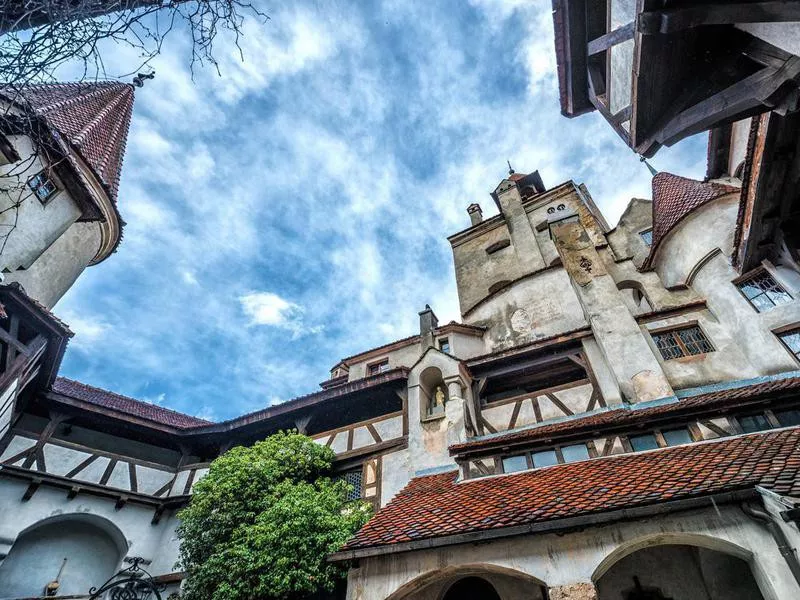
AleksandarGeorgiev / Getty Images
Bran Castle was built in the 14th century on what was then the border between Transylvania and Wallachia (both now regions in Romania) to control the border and collect customs taxes. Vlad the Impaler, the inspiration for Bram Stokers’ Count Dracula, once ruled over Wallachia.
As Vlad was once imprisoned in Bran Castle, Stoker used it as the model for his undead fictional character’s own residence. The site has been turned into a museum, and about 835,000 tourists visit it each year.
23. The Acropolis
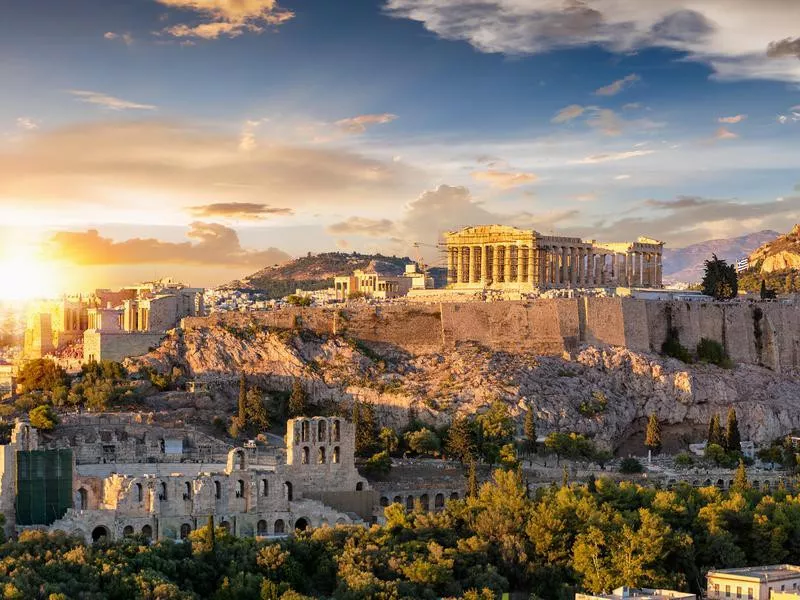
SHansche / Getty Images
Location: Athens, Greece
Architect: Iktinos, Kalikrates, Mnesikles & Erechtheion
Year built: 447 - 406 BC
Square footage: 14.7 acres (640,332 square feet)
Bottom Line: The Acropolis
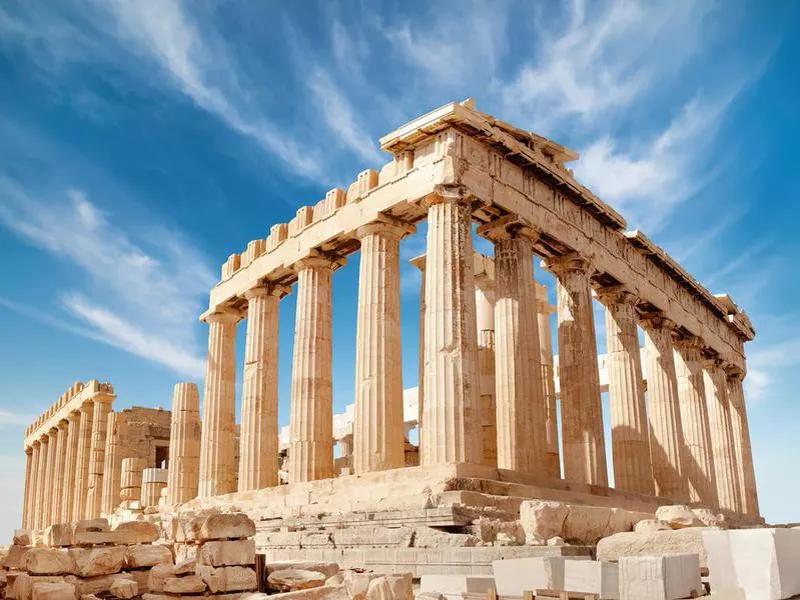
anyaivanova / Getty Images
The Acropolis is a temple and monument complex built on a hill that towers above the city of Athens. The area is dominated by the Parthenon, a temple dedicated to the goddess Athena, the patron of Athens. The great Athenian ruler Pericles began construction of the site during the golden age of the city-state at a time when Greek democracy and art flourished.
Work continued after his death under a succession of architects. The complex is a UNESCO World Heritage site and receives over 1 million visitors annually.
22. Cathedral of Brasilia
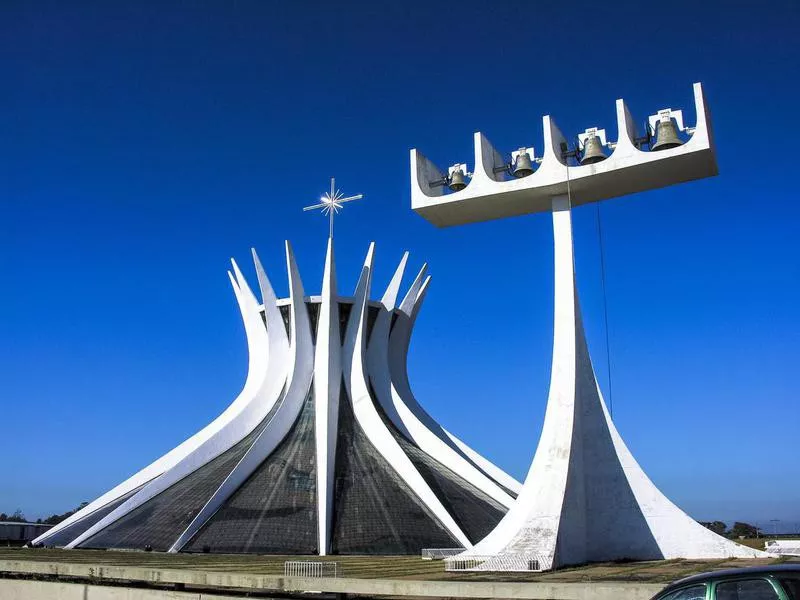
alffoto / Getty Images
Location: Brasilia, Brazil
Architect: Oscar Niemeyer
Year built: 1958 - 1970
Square footage: 30,418 square feet
Bottom Line: Cathedral of Brasilia
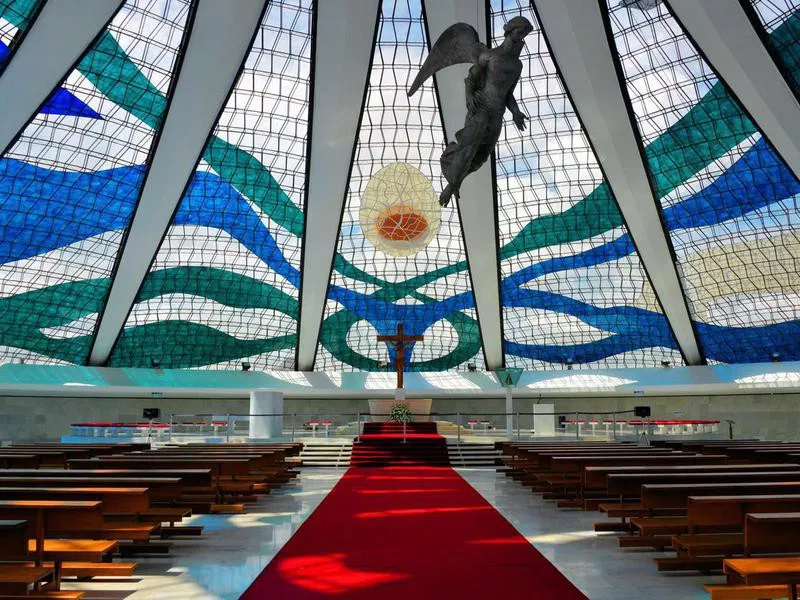
mtcurado / Getty Images
The Cathedral of Brasilia is the main Roman Catholic cathedral for the archdiocese of Brasilia. The circular, ribbed structure supports massive stained glass windows and holds up to 4,000 people inside. The bell tower contains four bells, which were donated by Spain.
Inside, three large sculptures of angels, weighing up to 660 pounds, are suspended by steel cables over worshippers. The church has become a popular tourist attraction. With more than 1 million visitors a year, the cathedral is the most popular tourist attraction in Brasilia.
21. Houses of Parliament (Palace of Westminster)
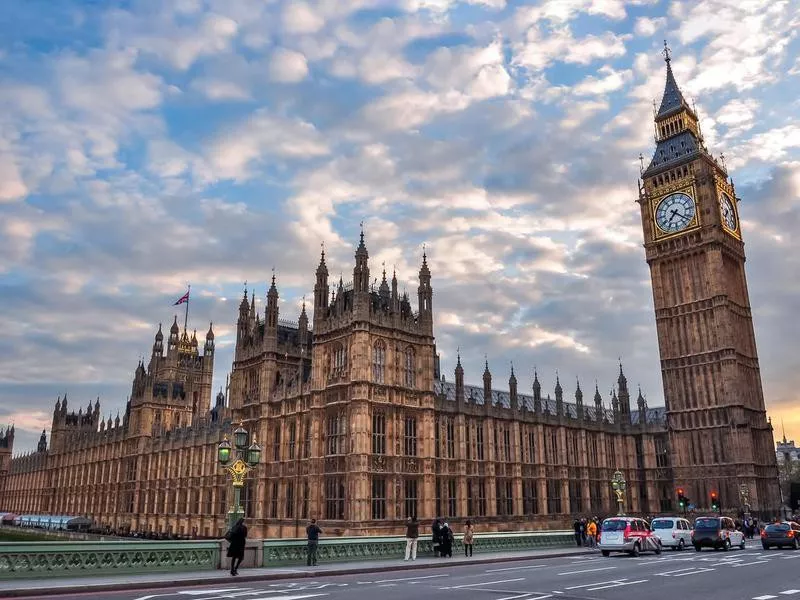
Vladislav Zolotov / Getty Images
Location: London, England
Architect: Sir Charles Barry
Year built: 1837 - 1860
Square footage: 1.2 million square feet
Bottom Line: Houses of Parliament
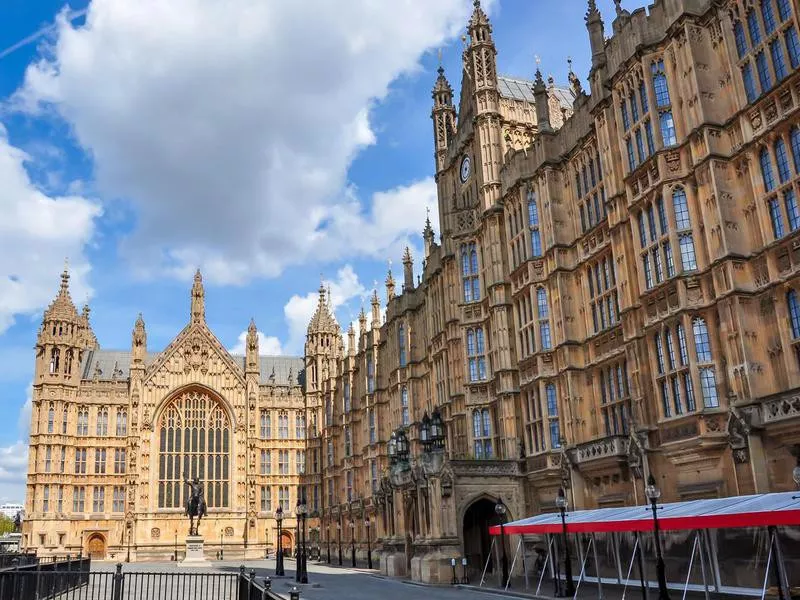
Vladislav Zolotov / Getty Images
The Houses of Parliament — technically the former Palace of Westminster — is England’s most iconic building and a UNESCO World Heritage site. A few of the original buildings date back to the 11th century. The current estate contains Westminster Abbey as well as chambers and offices for the House of Commons and the House of Lords, Britain’s two main governing bodies, and receives over 1 million visitors a year.
The world famous Big Ben is actually the name of the great bell, cast and hung in 1859, in the clock-faced Elizabeth Tower.
20. Potala Palace
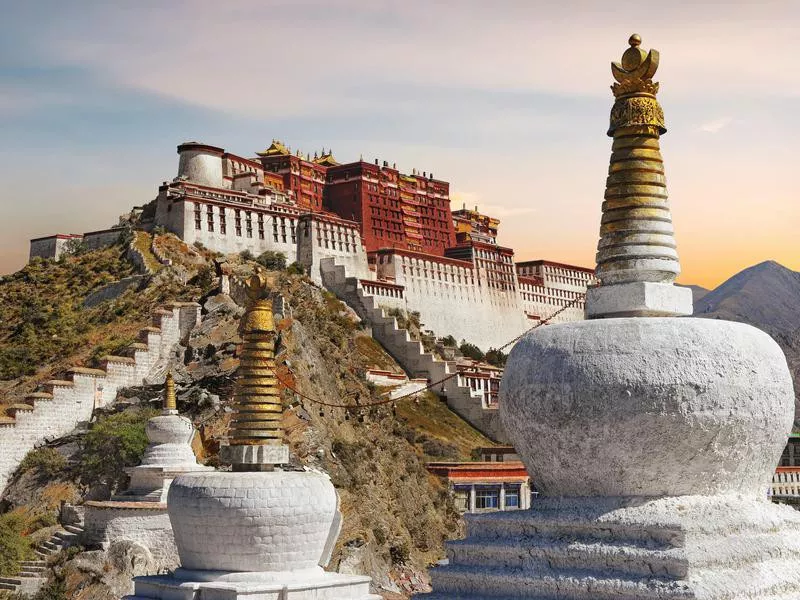
Hung_Chung_Chih / Getty Images
Location: Lhasa Valley, Tibet
Architect: Unknown
Year built: 1649
Square footage: 3.87 million square feet
Bottom Line: Potala Palace
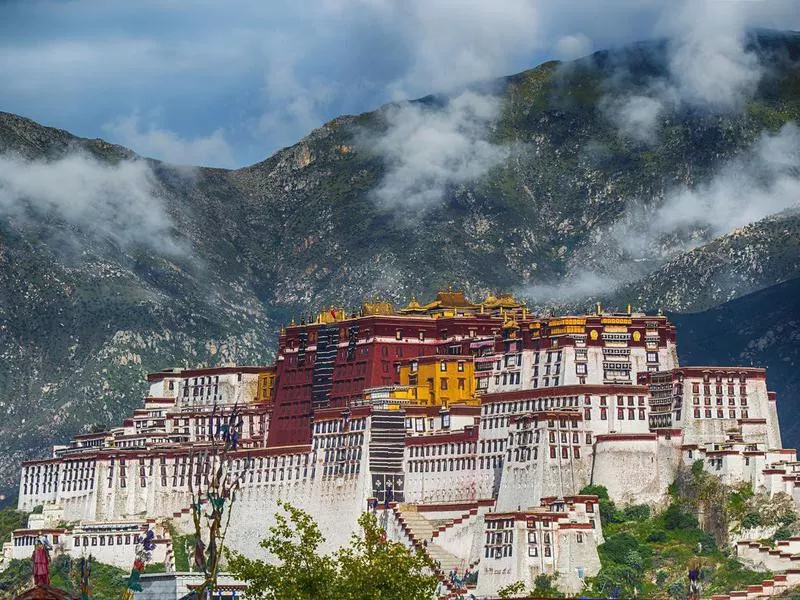
guenterguni / Getty Images
The 13-story Potala Palace was a religious and administrative center of Tibet and the winter palace of the Dalai Lama, the country’s spiritual leader. The complex, with its separate red and white buildings, is the highest palace in the world.
The site is now a museum, containing thousands of sacred texts, works of art and statues made from precious metals and gems. The Potala Palace is a UNESCO World Heritage site and a popular pilgrimage palace for Buddhists, receiving 1.45 million tourists a year.
19. The CN Tower
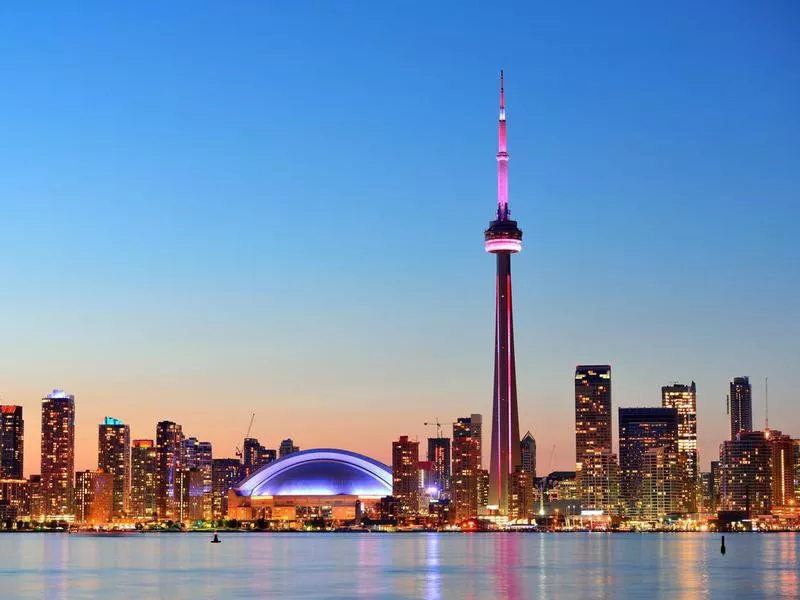
rabbit75_ist / Getty Images
Location: Toronto, Canada
Architect: John Andrews Architects & Web, Zerafa, Menkes, Houston Partnership
Year built: 1976
Height: 1,815 feet
Bottom Line: The CN Tower
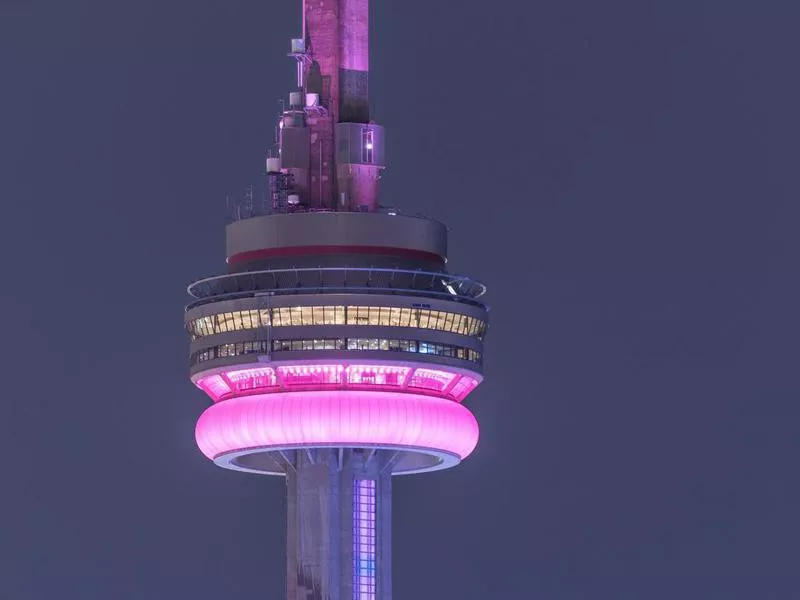
Kyle Bedell / Getty Images
The CN Tower was built by the Canadian National Railway company and quickly became one of the country’s most famous landmarks. In the 1960s and ’70s, Toronto was experiencing a building boom, and too many office blocks were blocking radio and TV signals. The city needed a dedicated radio and television broadcasting station that would rise above the skyline.
The CN Tower was the world’s tallest structure for nearly 35 years and is still the tallest tower in the western hemisphere. About 1.5 million people visit the tower each year.
18. Chichen Itza’s Temple of Kukulkan
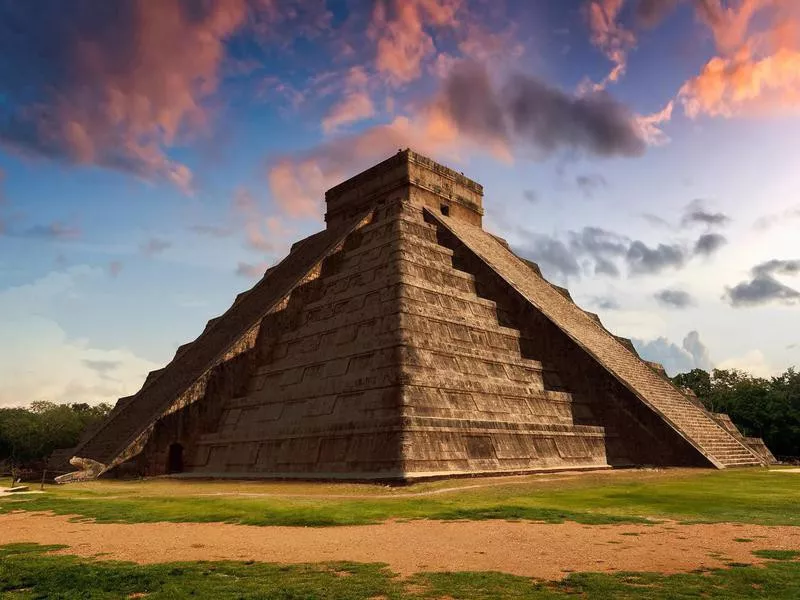
SOMATUSCANI / Getty Images
Location: Yucatan Peninsula, Mexico
Architect: Unknown
Year built: 1000 AD
Square footage: 32,761 square feet
Bottom Line: Chichen Itza
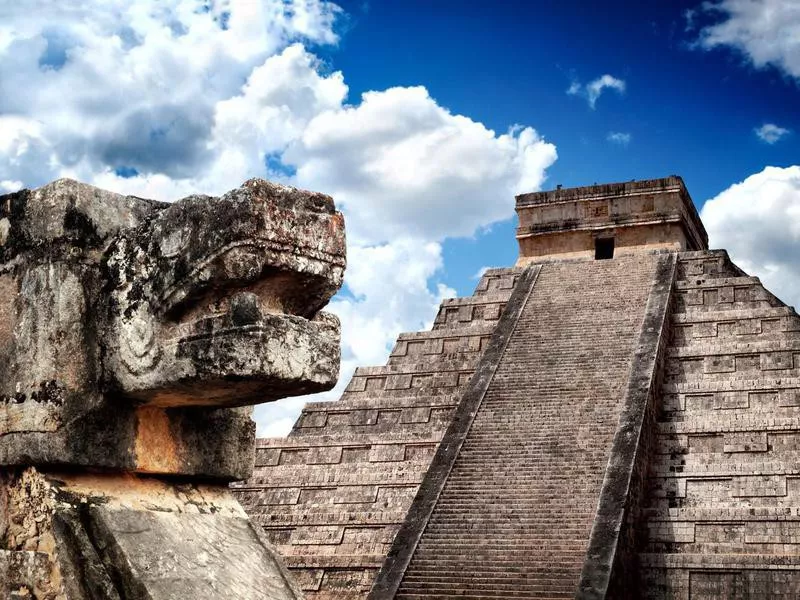
chuvipro / Getty Images
One of Mexico’s top archeological sites, Chichen Itza is a Pre-Columbian city, built by the Mayans. The builders organized the city in clusters of temples and pyramids. The Temple of Kukulkan (the Mayan feathered serpent god) is the most famous and dominates the city.
During both equinoxes, shadows on the steps of the pyramid look like a serpent slithering down. Chichen Itza includes other well-known sites, such as the Great Ball Court and the Temple of the Jaguars. The ruins are a UNESCO World Heritage site and receive 2 million visitors annually.
17. Machu Picchu
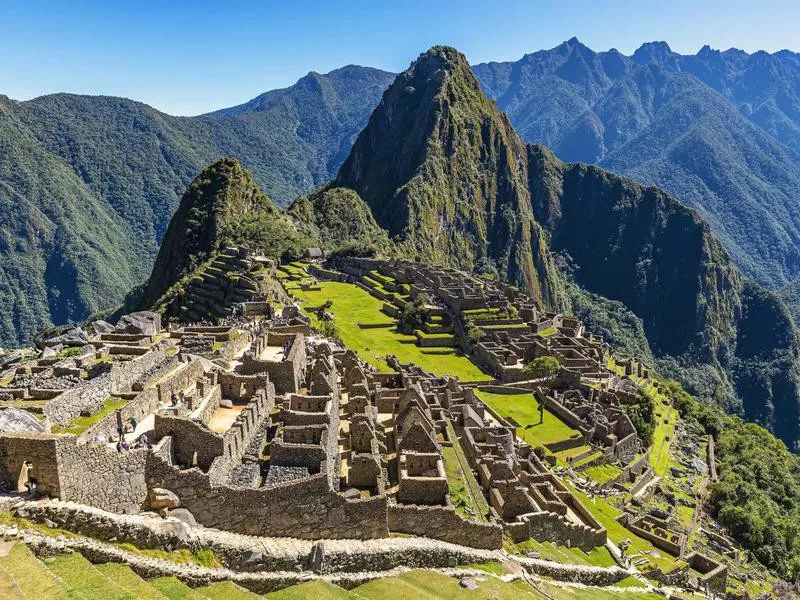
SL_Photography / Getty Images
Location: Urubamba Province, Peru
Architect: Unknown
Year built: 1450 AD
Square footage: 1 million square feet
Bottom Line: Machu Picchu
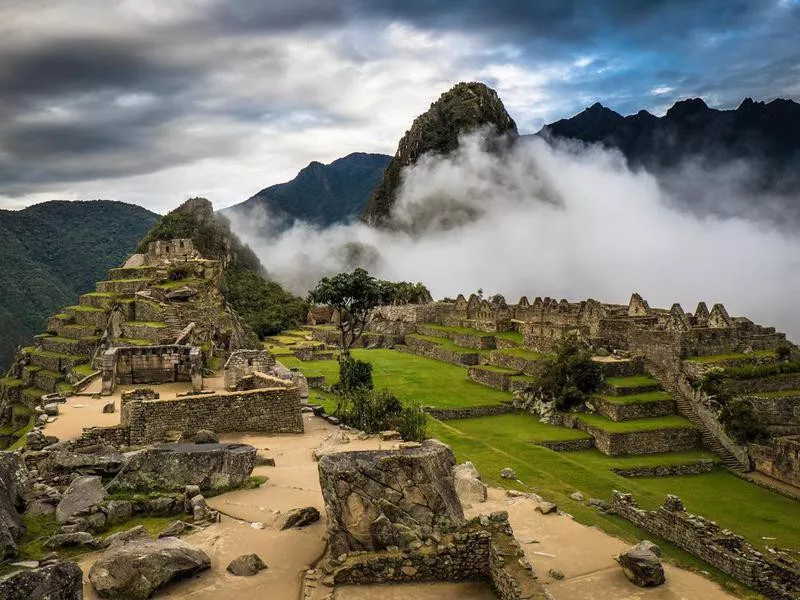
zodebala / Getty Images
Machu Picchu was a ceremonial center and royal retreat built by the Incas high in the Andes Mountains. The city consisted of over 150 buildings, temples and plazas connected by narrow lanes and footpaths and manmade terraces on the mountain slopes for growing food. Machu Picchu was likely designed as a retreat for the wealthy ruling class and their workers.
Spanish conquerors who invaded Peru never found Machu Picchu, and it remained lost until 1911. Roughly 2 million people visit Machu Picchu each year, and the site is on the UNESCO World Heritage list.
16. Himeji Castle
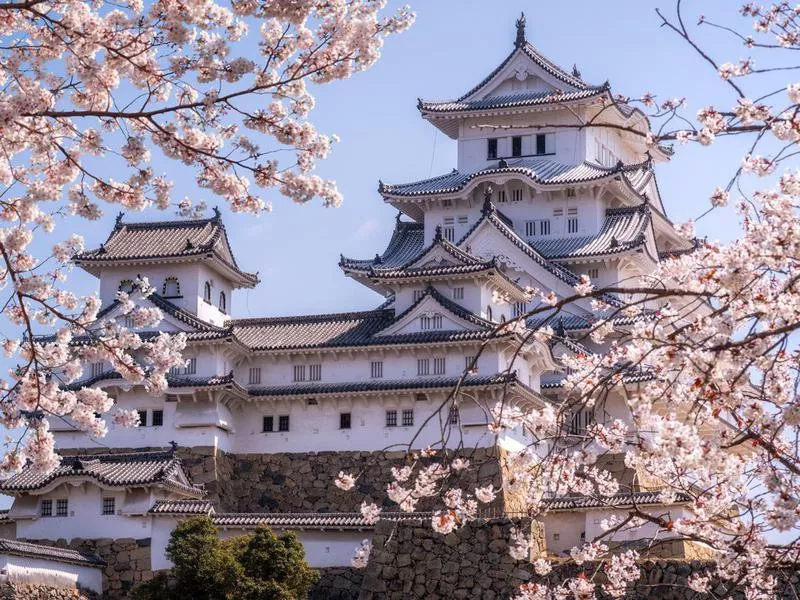
Eloi_Omella / Getty Images
Location: Kyoto, Japan
Architect: Unknown
Year built: 1400 - 1609
Square footage: 107 hectares (11.5 million square feet)
Bottom Line: Himeji Castle
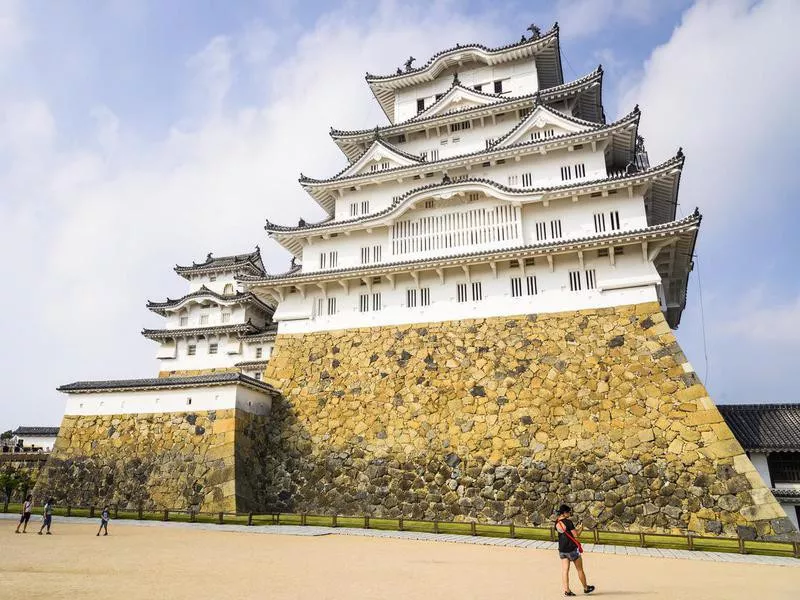
BING-JHEN HONG / Getty Images
The Himeji Castle, also known as the White Heron Castle, is Japan’s best-kept feudal period castle. The site contains over 80 separate buildings, connected by gates and winding paths and massive fortified walls. In the center of the complex lies the main castle keep, a six-story white wooden structure.
The castle is both a UNESCO World Heritage site and a Japanese national treasure. The site receives more than 2.87 million visitors annually and is the most-visited castle in Japan.
15. Basilica La Sagrada Familia (Basilica of the Holy Family)
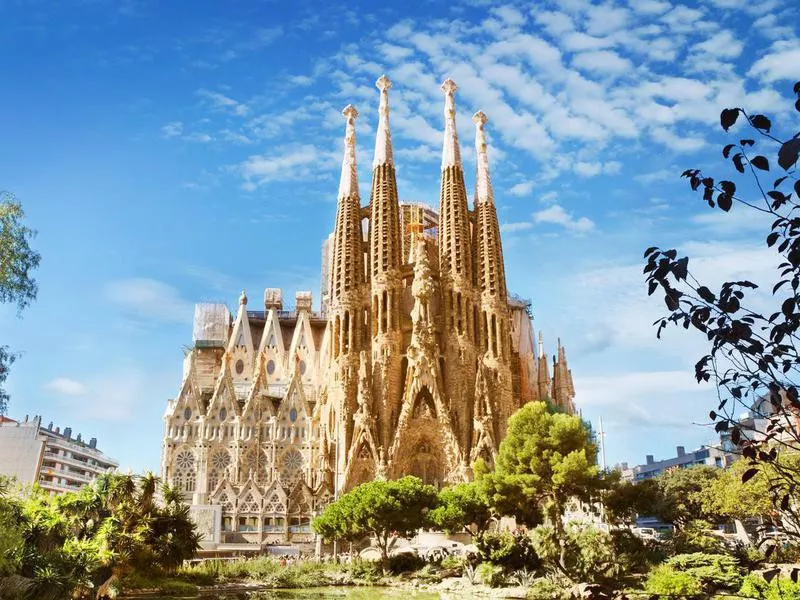
narvikk / Getty Images
Location: Barcelona, Spain
Architect: Antoni Gaudi
Year built: 1883 - 2026
Square footage: 48,500 square feet
Bottom Line: Basilica La Sagrada Familia
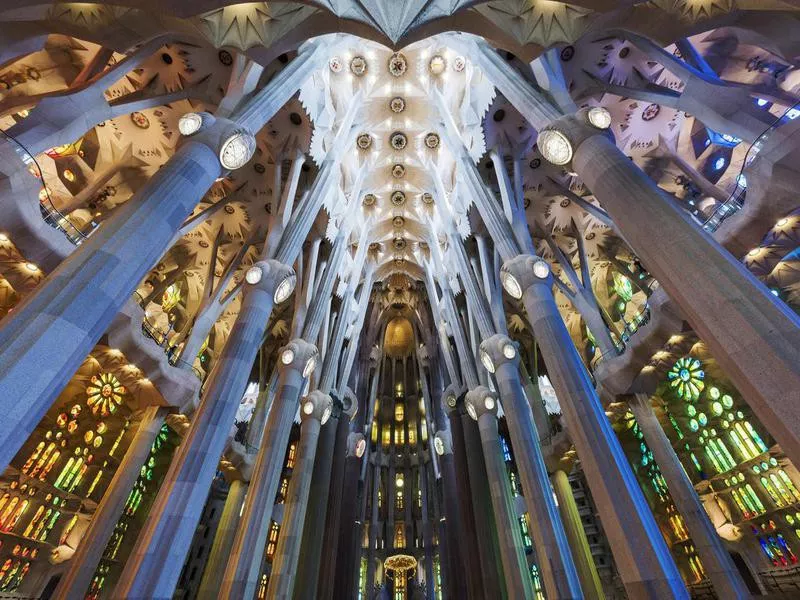
omersukrugoksu / Getty Images
The original architect of the basilica planned a Gothic revival building but had only built the crypt before he resigned and Antoni Gaudi took over. The architect Gaudi had a very different vision and created a “church of the future” with columns resembling tree trunks, motifs and designs from nature and a modern-looking facade.
Gaudi spent over 40 years working on the project, and his assistants continued the work after his death. The church is expected to be completed soon (maybe?) and is a UNESCO World Heritage site. Over 3 million people visit the Basilica each year.
14. Burj Khalifa
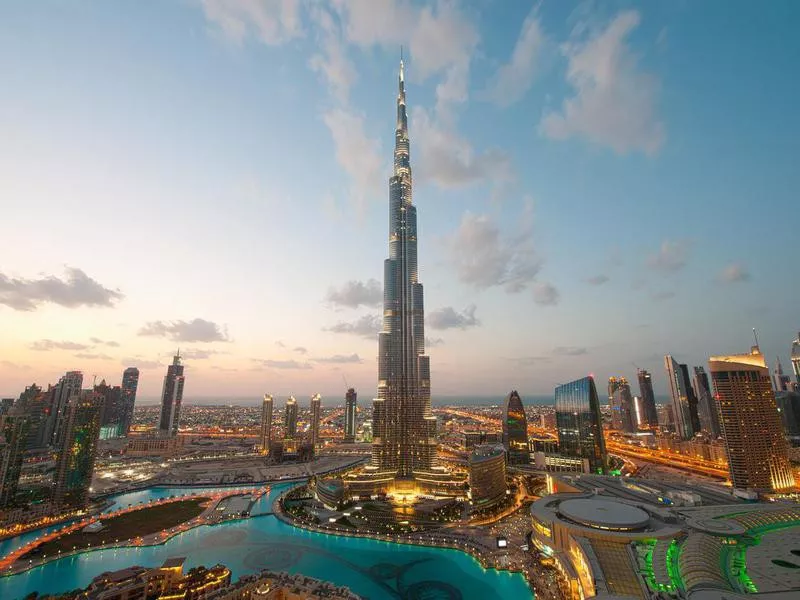
dblight / Getty Images
Location: Dubai, United Arab Emirates
Architect: Skidmore, Owings and Merrill
Year built: 2004 - 2010
Height: 2,716.5 feet
Bottom Line: Burj Khalifa
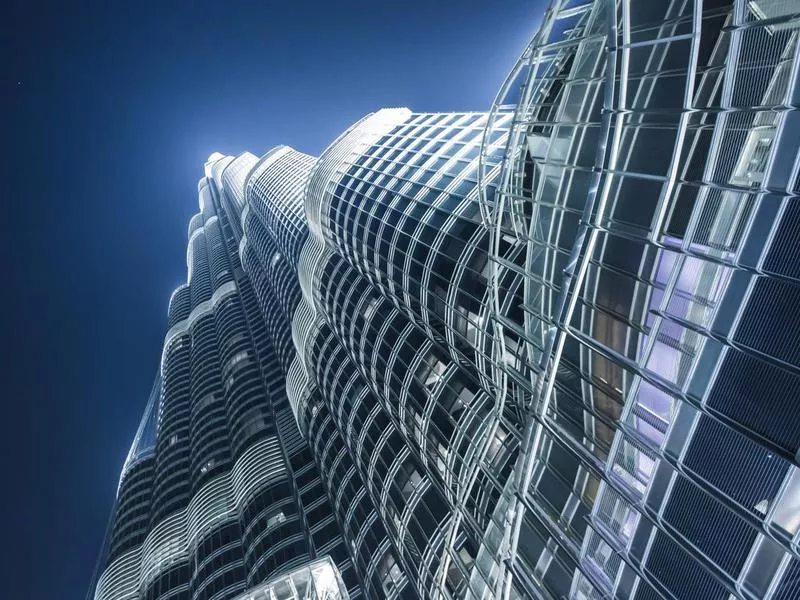
olegmj / Getty Images
The lobed, spired Burj Khalifa is the world’s tallest building. The design is reminiscent of a spider lily and was the winner of an invitation-only competition open to global architects. The tower’s interior was inspired by local culture and is filled with 1,000 works of art from Middle Eastern and international artists.
The Burj Khalifa contains the Armani Hotel — the world’s only seven-star hotel — luxury residential suites, a shopping mall and corporate offices. The tower is the most popular tourist attraction in Dubai, with over 3.5 million visitors each year.
13. Dome of the Rock
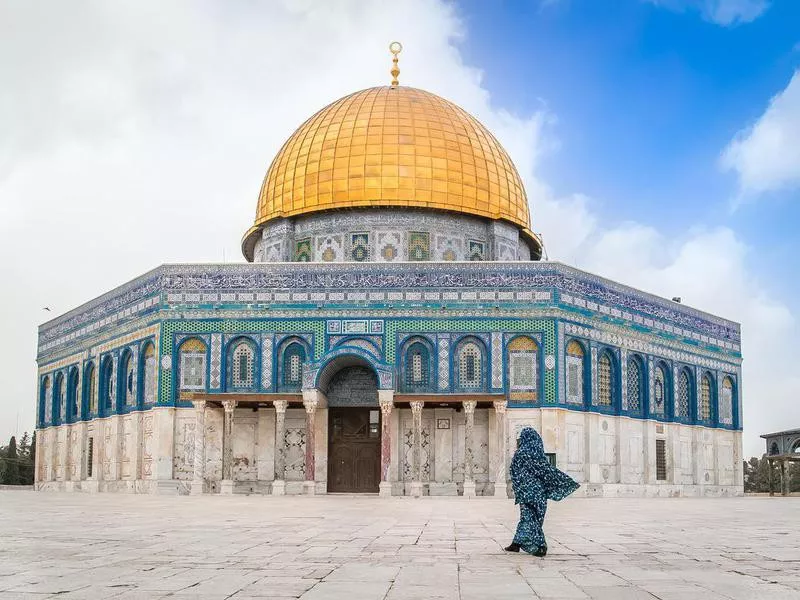
Anna Zolnay / Getty Images
Location: Jerusalem, Israel
Architect: Raja ibn Hayweh and Yazid ibn Salam
Year built: 685 - 691 AD
Height: 98.4 feet
Bottom Line: The Dome of the Rock
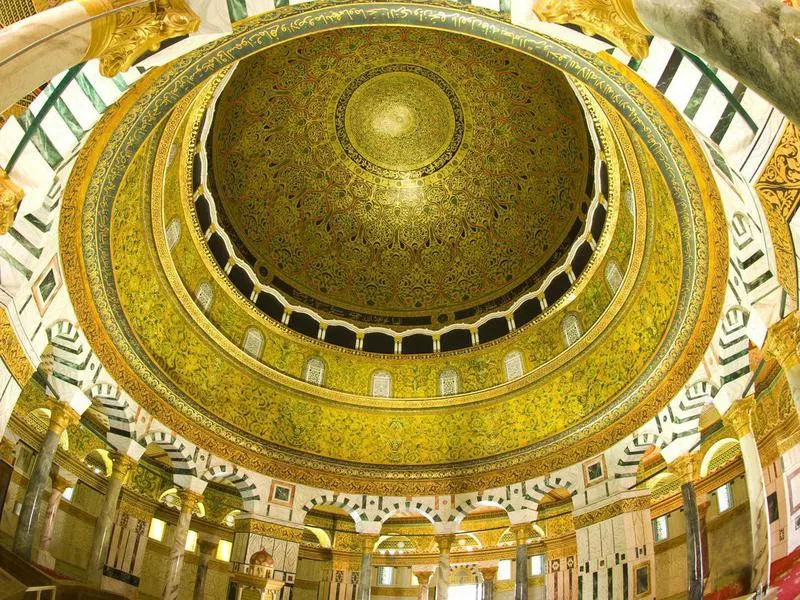
yuliang11 / Getty Images
This shrine sits within the Temple Mount on top of a rock that is a sacred site for Jewish, Christian and Muslim faiths. The Temple Mount was also once the site of Solomon’s Temple. The current building was originally created as a shrine for pilgrims, was later converted into a mosque and is the oldest known Muslim monument.
The interior is lavishly filled with mosaics, multi-colored tiles, marble, carved stone and inscribed verses of the Koran. The Dome is a UNESCO World Heritage site, and the city of Jerusalem receives around 3.5 million visitors annually.
12. Hagia Sophia
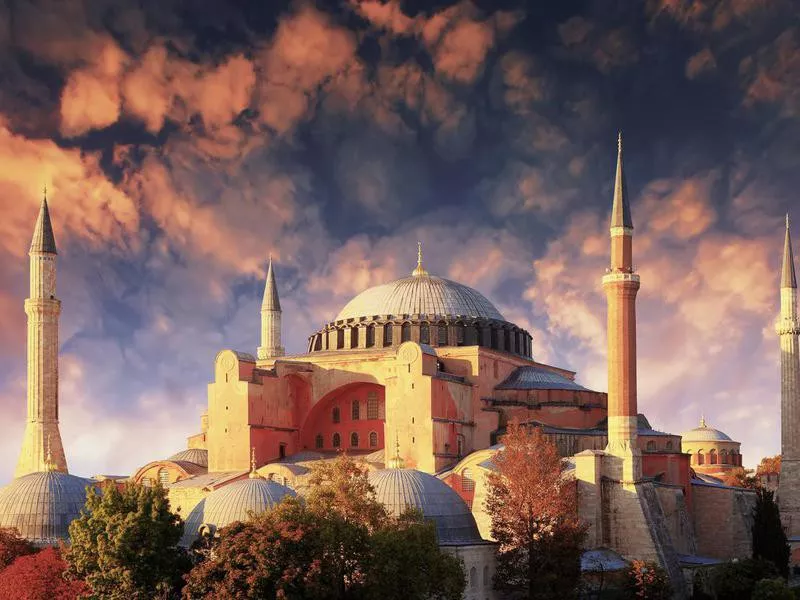
Tolga TEZCAN / Getty Images
Location: Istanbul, Turkey
Architect: Isidoros Milet and Anthemius Tralles
Year built: 532 - 537 AD
Square footage: 200,000 square feet
Bottom Line: Hagia Sophia
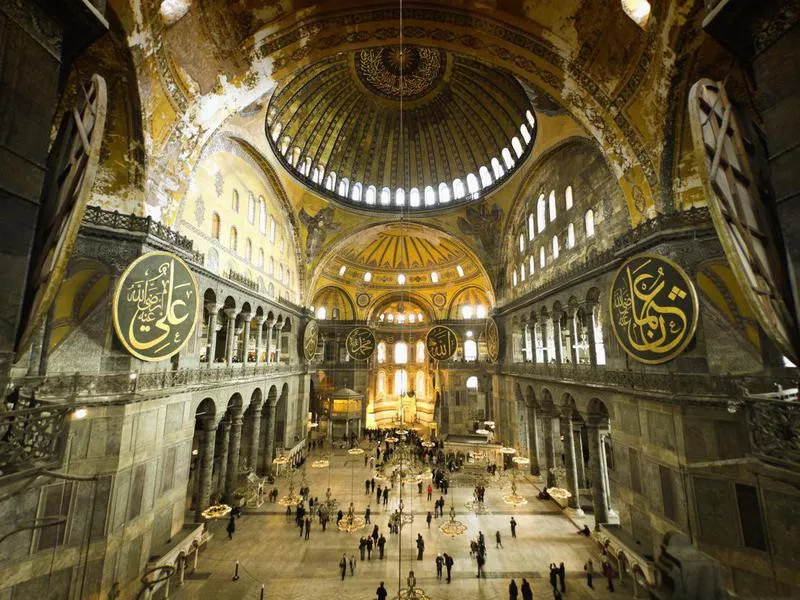
funky-data / Getty Images
The Hagia Sophia was the central church of the Byzantine Empire in the city of Constantinople (now Istanbul) and was commissioned by Emperor Justinian I. The current Hagia Sophia is actually the third one built, after the first two were burned in riots.
Justinian decreed that each province in his empire send architectural materials to be included in the new basilica. After Ottomans conquered the city in 1453, the church was converted to a mosque. The Hagia Sophia is the most popular historical site in Turkey, with over 3.7 million visitors annually.
11. The Empire State Building
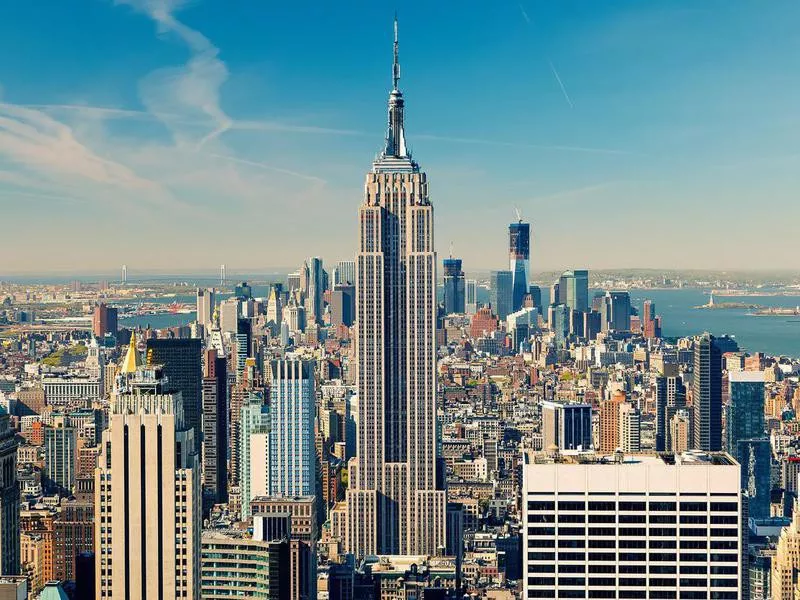
sborisov / Getty Images
Location: New York City, United States
Architect: Shreve, Lamb and Harmon Associates
Year built: 1931
Height: 1,454 feet
Bottom Line: The Empire State Building
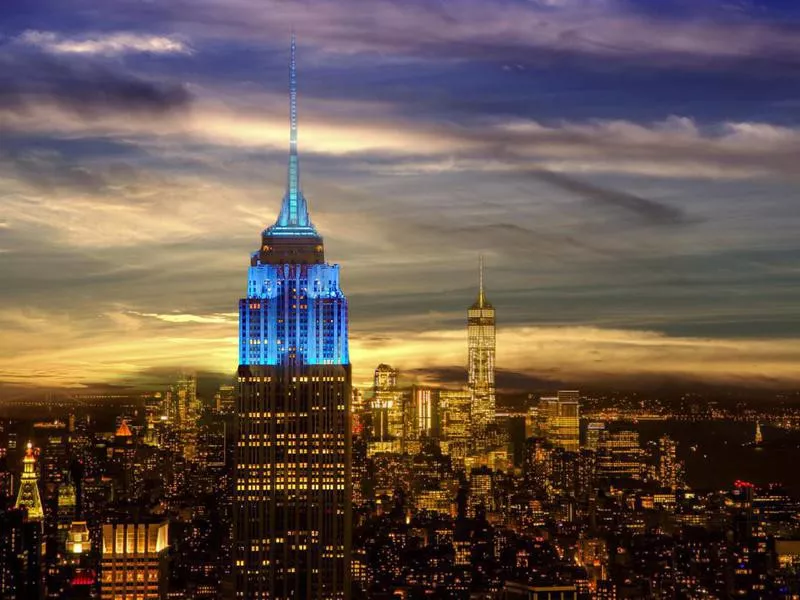
fstop123 / Getty Images
The Empire State Building was the first building with over 100 floors and a modern steel frame, and until 1971, it was the tallest in the world. The lighting, glasswork and marble interior show the Modernist Art Deco style of the era.
The building site provided crucial jobs at the height of the Great Depression, but offices were largely vacant when the building officially opened due to the economic crash. The 86th floor offers 360-degree views of the city. It happens to be the most photographed building in the world and is visited by over 4 million people annually.
10. Borobudur Temple
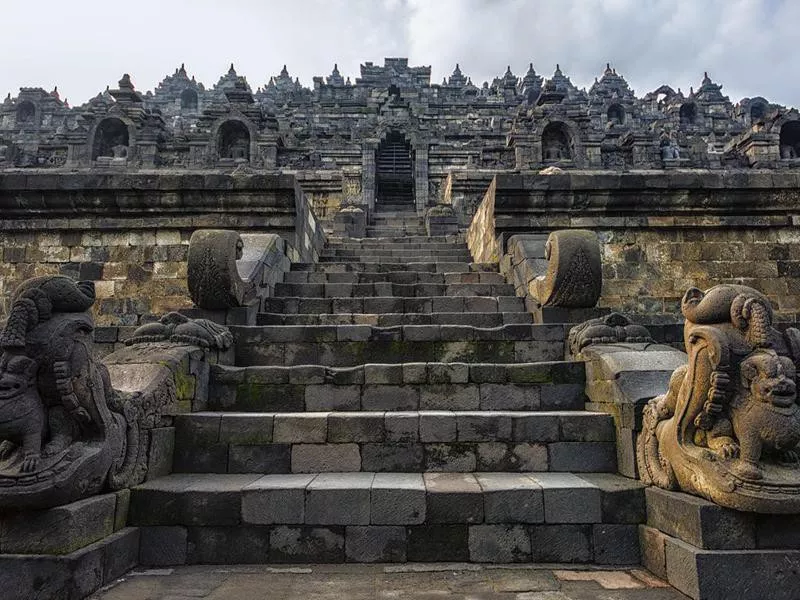
StockByM / Getty Images
Location: Magelang, Indonesia
Architect: Gunadharma
Year built: 8th - 9th century AD
Square footage: 162,847 square feet
Bottom Line: Borobudur Temple
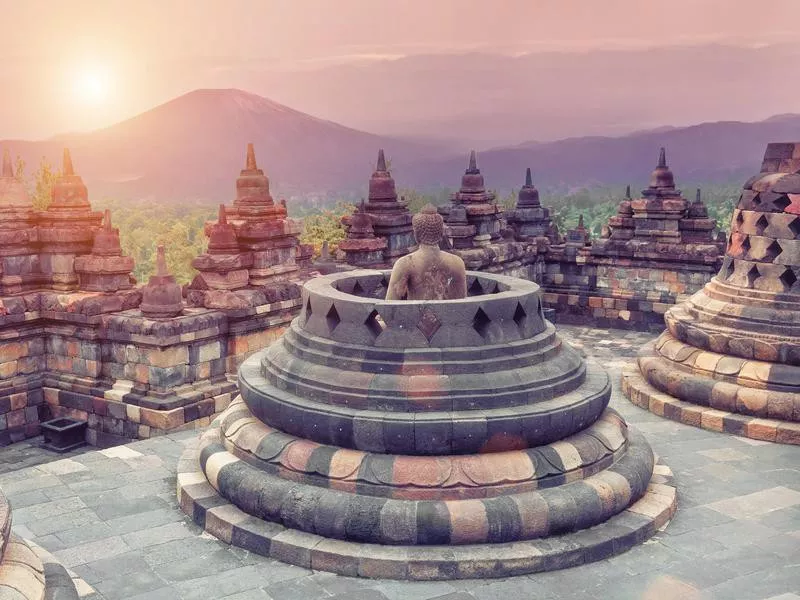
vicnt / Getty Images
Borobudur is a Buddhist temple built in the eighth to ninth centuries. The site is decorated with 2,672 relief panels, showing the life and teachings of the Buddha, and 504 Buddha statues, all carved from stone. The builders didn’t use cement or mortar, instead fitting all the stone blocks together like a jigsaw puzzle.
The site was abandoned in the 15th century, buried in volcanic ash. It was only rediscovered in 1815 and restored in the 1960s. The Borobudur Temple is a UNESCO World Heritage site and visited by about 5 million people annually.
9. The Sistine Chapel
Location: Vatican City
Architect: Giovanni dei Dolci
Year built: 1473 - 1481
Square footage: 5,808 square feet
Bottom Line: The Sistine Chapel
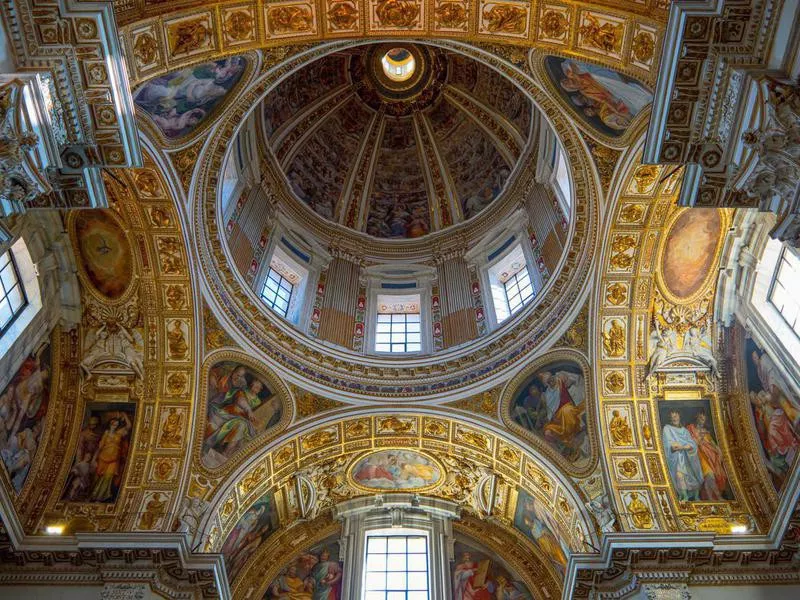
Gim42 / Getty Images
Surrounded by Rome, Italy, Vatican City is technically the world’s smallest country — smaller than New York’s Central Park. Inside this city-state, the papal palace contains a small chapel for the Pope’s personal use, called the Sistine Chapel, after Pope Sixtus IV who commissioned it. The chapel is famous for the Renaissance-era frescoes painted by Michelangelo on the ceiling, showing biblical themes.
Traditionally, the cardinals meet in the Sistine Chapel to elect a new Pope. When one is chosen, white smoke is released from the chapel’s chimney. Around 5 million people visit the chapel each year.
8. Cologne Cathedral
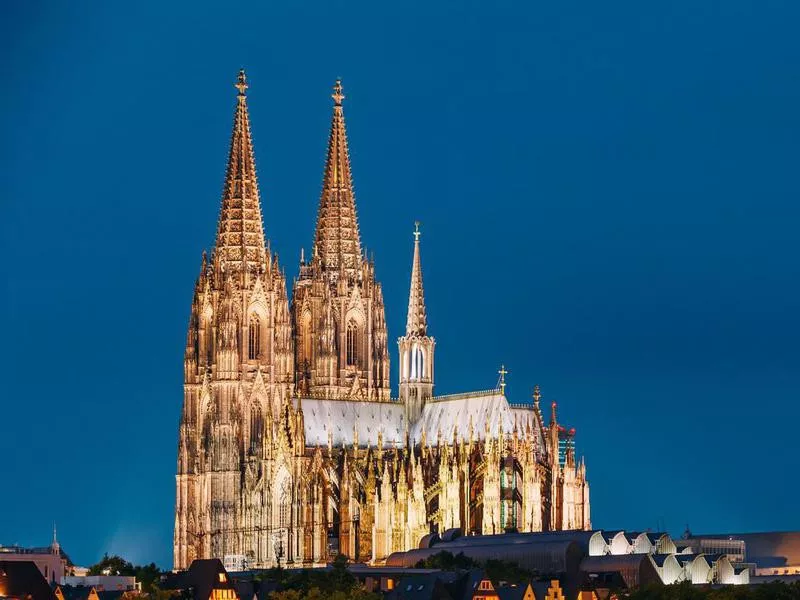
bruev / Getty Images
Location: Cologne, Germany
Architect: Master Gerhard von Ryle
Year built: 1248 - 1880
Square footage: 26,250 square feet
Bottom Line: Cologne Cathedral

justhavealook / Getty Images
The Cathedral was started in the Middle Ages as a shrine for the reputed bones of the Bible’s Three Wise Men. Gerhard von Ryle was the Master Mason who laid out the original design and oversaw the earliest construction. The cathedral became one of the most-visited pilgrimage sites in Europe.
The building work wasn’t completed until 1880 when the two towers were installed. About 6.5 million people visit the cathedral every year, making it Germany’s most popular historic attraction. The cathedral was made a UNESCO World Heritage building in 1996.
7. Taj Mahal
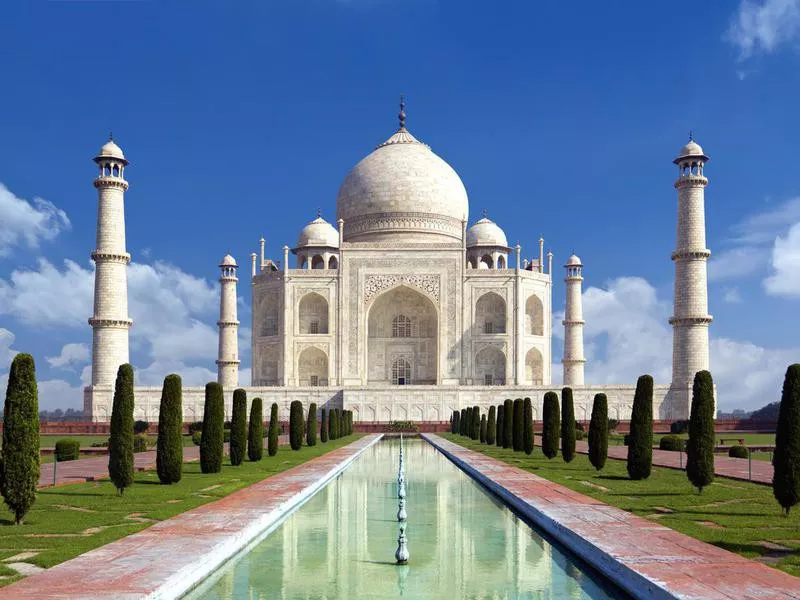
somchaisom / Getty Images
Location: Agra, India
Architect: Ustad Ahmad
Year built: 1648 - 1654
Square footage: 35,167 square feet
Bottom Line: Taj Mahal
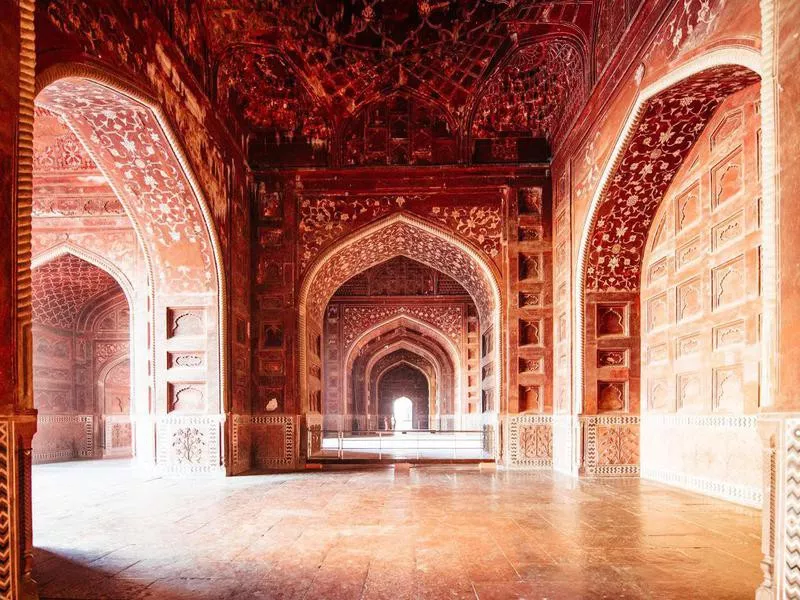
ferrantraite / Getty Images
The iconic Taj Mahal was built as a tomb by Mughal Emperor Shah Jahan for his beloved wife, Mumtaz Mahal. The name means “crown of palaces” in Persian. While it’s likely that a team of architects built it, Ustad Ahmad, the court architect at the time, is often given credit as the chief architect.
The Taj Mahal was made using white marble, decorated with jade, crystal, turquoise, lapiz, sapphire and carnelian, and it bears inscriptions inlaid with black marble. Roughly 6.5 million people visit the site annually, making it India’s most popular tourist attraction.
6. The Eiffel Tower
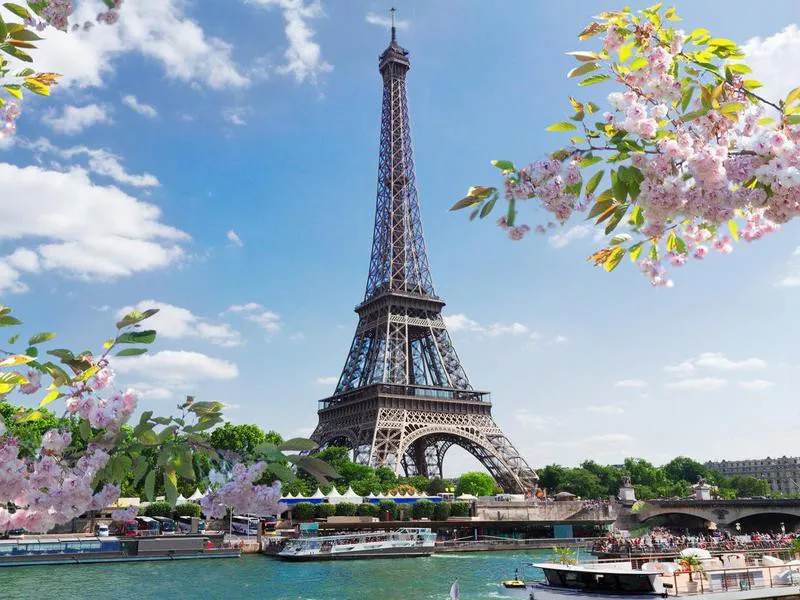
neirfy / Getty Images
Location: Paris, France
Architect: Stephen Sauvestre
Year built: 1887 - 1889
Height: 1,063 feet
Bottom Line: The Eiffel Tower
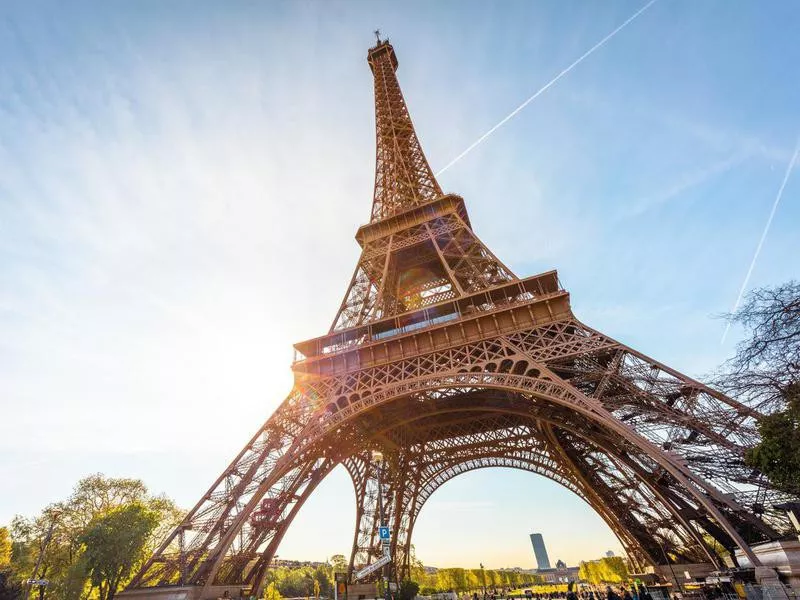
Nikada / Getty Images
The Eiffel Tower is France’s most iconic landmark and receives nearly 7 million visitors annually. The tower was built for the 1889 Exposition Universelle. The Exposition organizers wanted a 300-meter iron tower at the site and received 107 design submissions.
The winning entry came from Gustave Eiffel, who owned a civil engineering company. The Eiffel Tower was originally meant to stand for 20 years but found new life as a radio (and then television) transmitting post. These days, it would be hard to imagine the Paris skyline without this famous monument.
5. The Colosseum
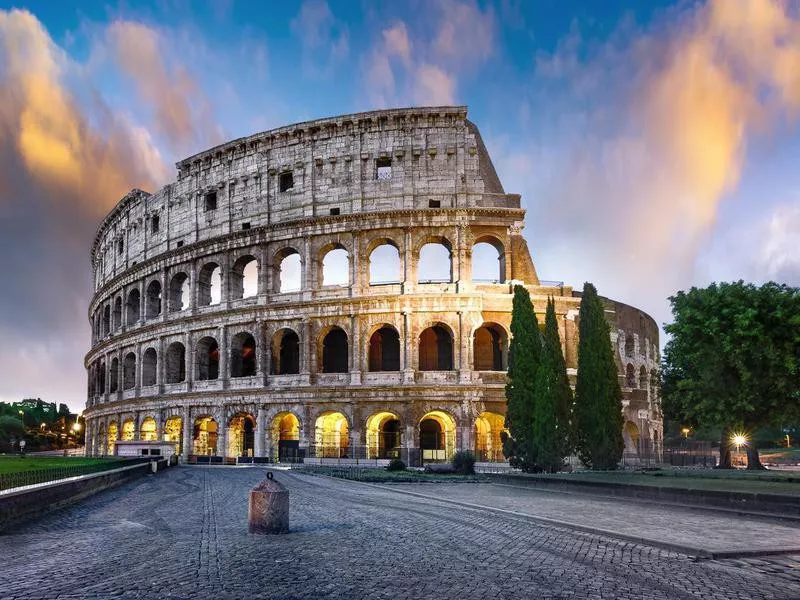
ventdusud / Getty Images
Location: Rome, Italy
Architect: Unknown
Year built: 70 - 80 AD
Square footage: 36,000 square feet
Bottom Line: The Colosseum
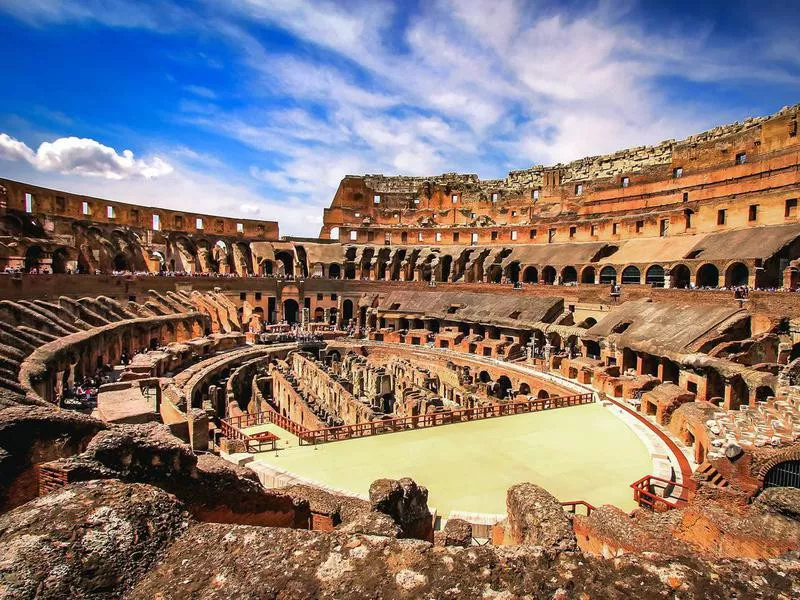
Kanawa_Studio / Getty Images
The Colosseum was commissioned by Emperor Vespasian in 70 or 72 AD. In 80 AD, Vespasian’s son, Emperor Titus, opened the elaborate structure, called the Flavian Amphitheater, with 100 days of games. The Colosseum was the largest of its kind in the world, and the first to be built free-standing and not against a hill.
Fifty-thousand Roman spectators sat on marble seats while watching animal hunts, gladiator fights, mock battles and executions. The site was active for over 400 years before falling into disuse. These days, the Colosseum receives roughly 7 million visitors annually.
4. Sydney Opera House
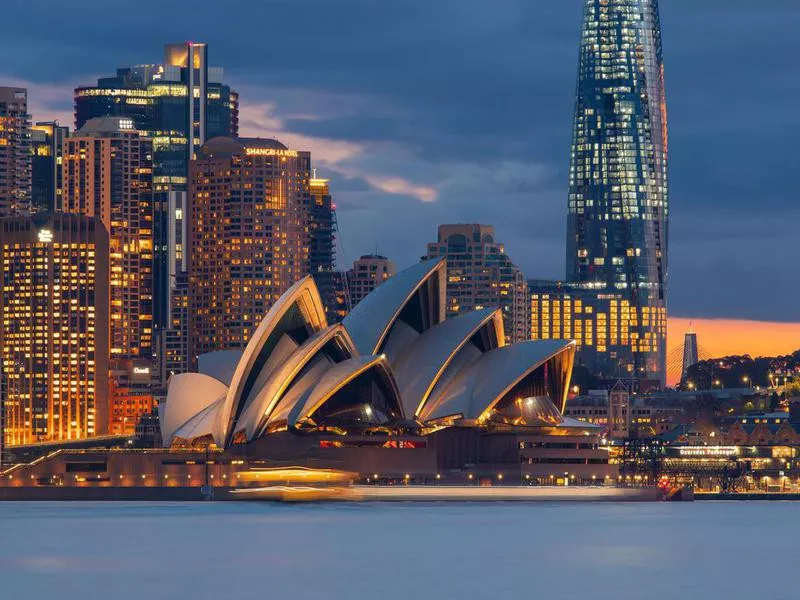
ai_yoshi / Getty Images
Location: Sydney, Australia
Architect: Jorn Utzon
Year built: 1959 - 1973
Square footage: 484,375 square feet
Bottom Line: Sydney Opera House
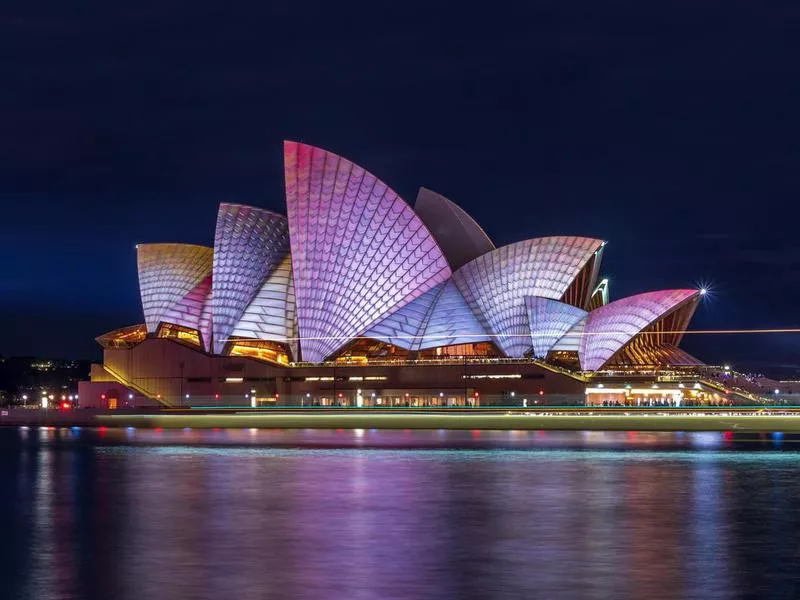
Saud Nassir / Getty Images
In 1956, Danish Architect Jorn Utzon, won an international contest to design a new opera house that would stand on the Sydney Harbour foreshore. His design is reminiscent of shells or a sail billowing in the wind (Utzon was a keen sailor).
Today, the Opera House is iconic, but at the time, it was controversial to use a curved design that looked like sculpture. The Opera House is one of the world’s busiest performing arts centers, and 8.2 million people visit it every year, making it Australia’s top tourist attraction.
3. Gardens by the Bay
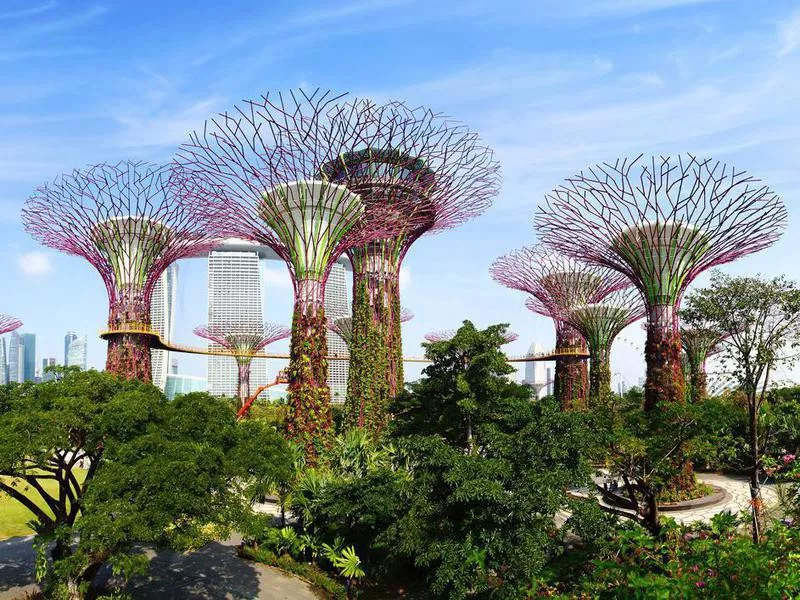
vidalidali / Getty Images
Location: Marina Bay, Singapore
Architect: Grant Associates & Wilkinson Eyre Architects
Year built: 2012
Square footage: 249.5 acres (10,868,220 square feet)
Bottom Line: Gardens by the Bay

Nikada / Getty Images
Gardens by the Bay contains greenhouses and three large gardens on Marina Bay. The site is best-known for its 18 “supertrees,” which are giant, tree-like structures that serve as vertical gardens. The supertrees are connected by walkways, and one even contains a restaurant at the top.
The Gardens host festivals, concerts, movie screenings, and sport and community events. The greenhouses are filled with plants and flowers from five continents and are popular with school groups. The Gardens won the World Building of the Year Award in 2012 and receives 13.7 million visitors annually.
2. The Forbidden City
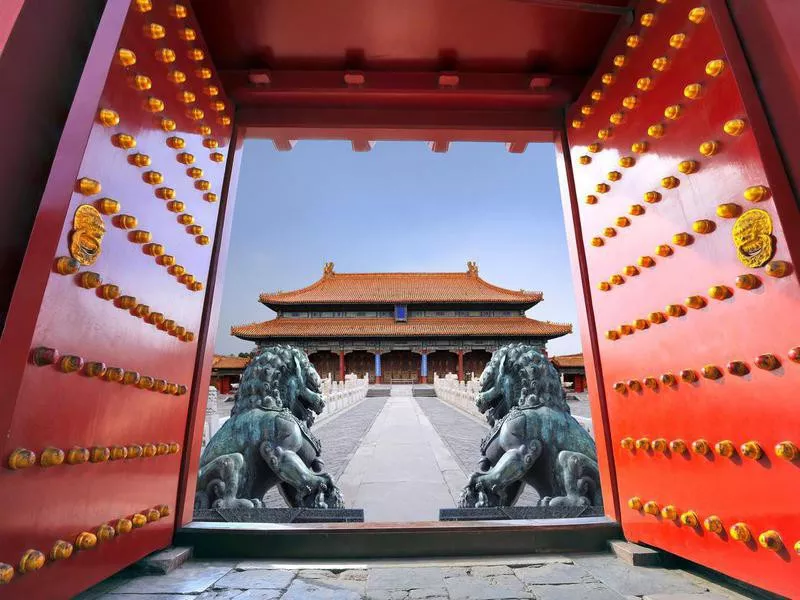
Hung_Chung_Chih / Getty Images
Location: Beijing, China
Architect: Kuai Xiang
Year built: 1406 - 1420 AD
Square footage: 7.7 million square feet
Bottom Line: The Forbidden City
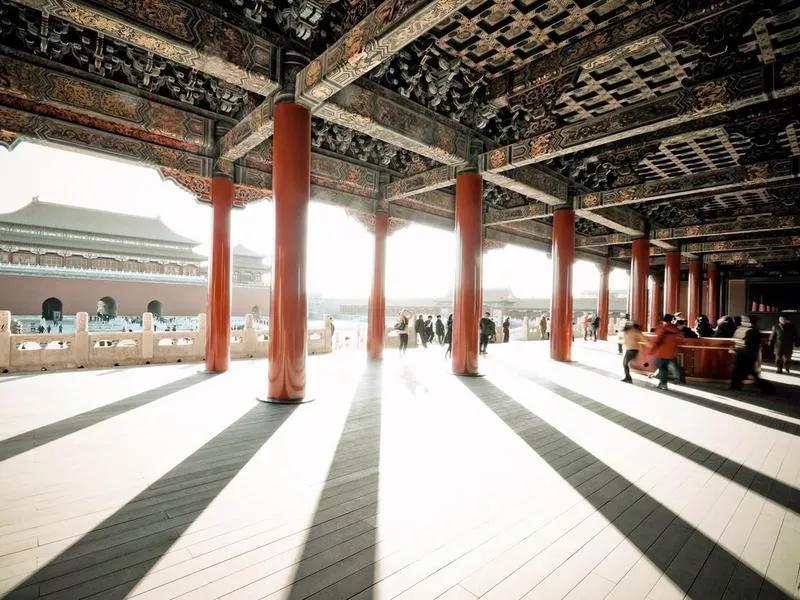
PhotoTalk / Getty Images
The Forbidden City was built during the Ming Dynasty and served as the royal residence of Chinese emperors until 1924. The complex contains 980 buildings — most are well-preserved wooden structures — and over 8,728 rooms. Once, only royal families and high officials were allowed to enter, hence the name.
The Palace Museum is one of the largest cultural museums in the world, housing antique porcelain, jade and other priceless relics. The city is a UNESCO World Heritage site and receives 14 million visitors annually, making it the top tourist attraction in China.
1. The Great Pyramid of Giza
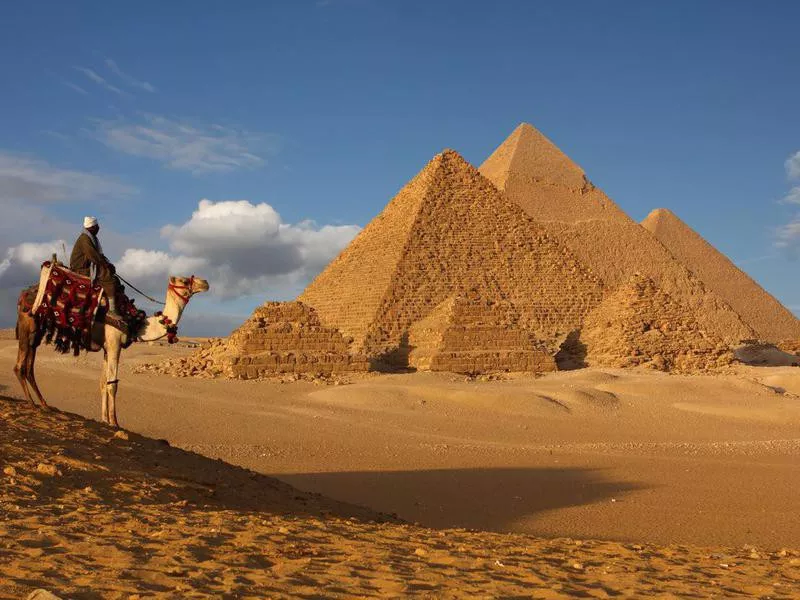
sculpies / Getty Images
Location: Cairo, Egypt
Architect: Hemiunu
Year built: 2589 - 2566 BC
Height: 479 feet
Bottom Line: The Great Pyramid of Giza
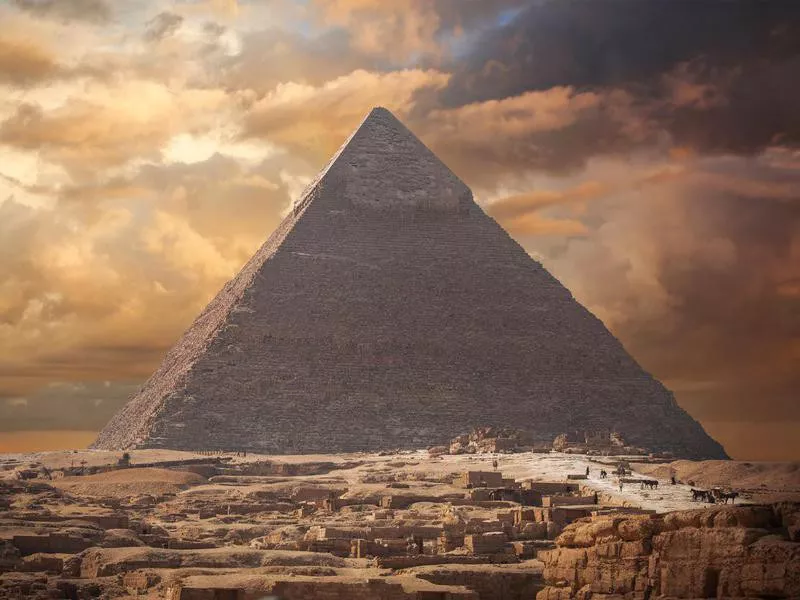
Lindrik / Getty Images
The Great Pyramid is the largest of three built on a plateau by the Nile River near modern-day Cairo. It was built as a mausoleum during the reign of Pharaoh Khufu (Cheops) and was the tallest man-made structure in the world for 3,000 years. The pyramid is built from over 2 million blocks of stone and was originally covered in white limestone, making it highly visible against the desert setting.
The pyramids were one of the Seven Wonders of the Ancient World and are now a UNESCO World Heritage site. The site receives over 14.7 million visitors each year.

